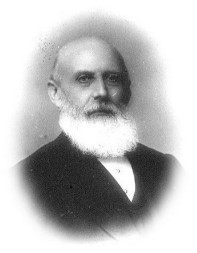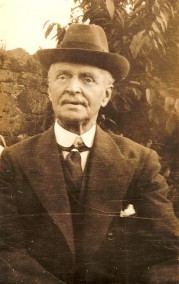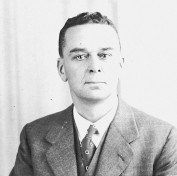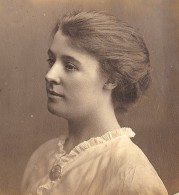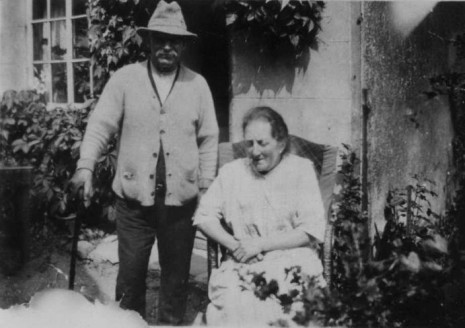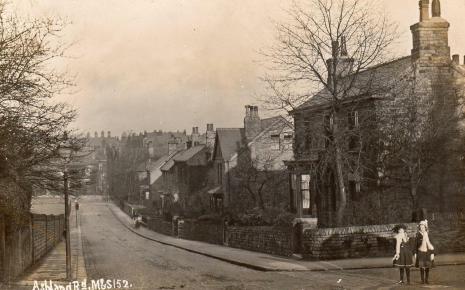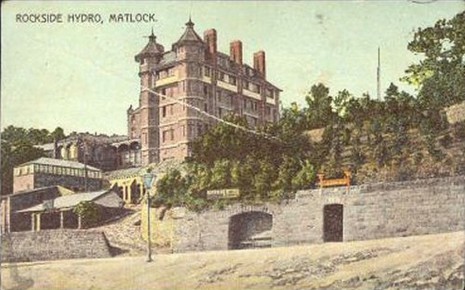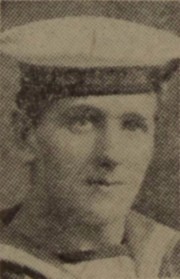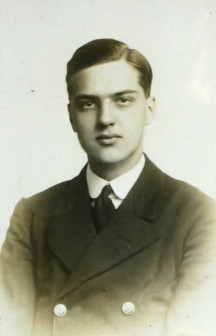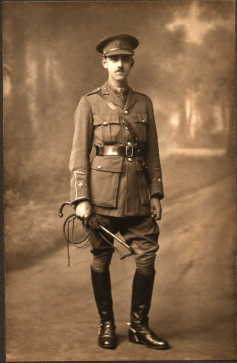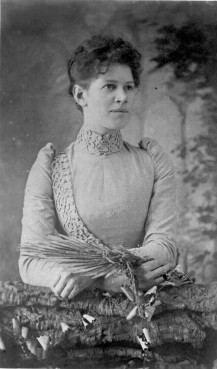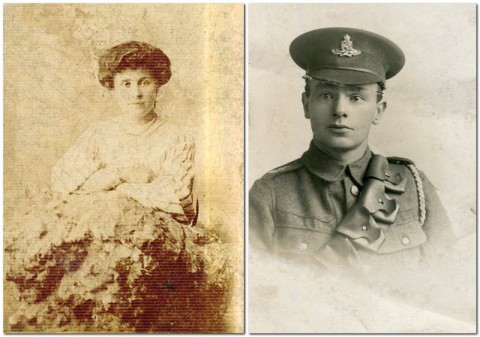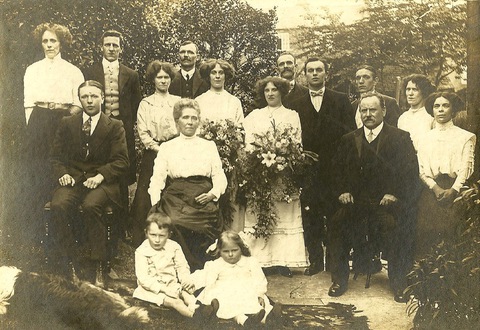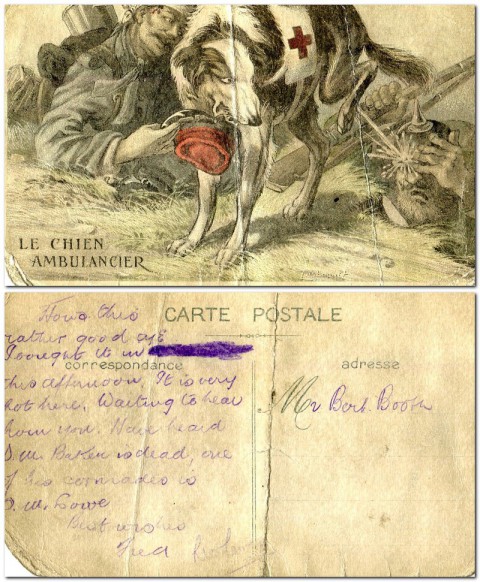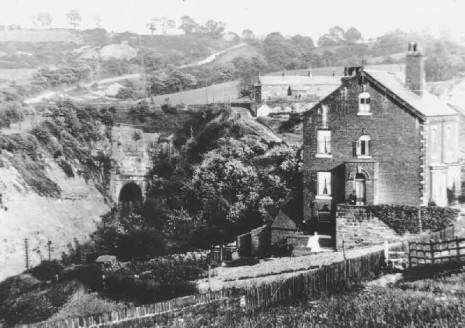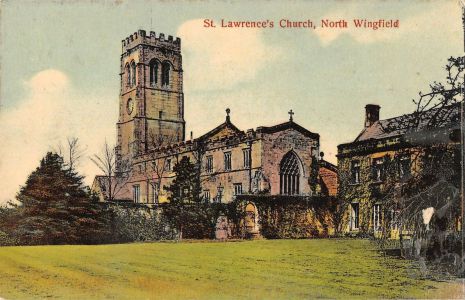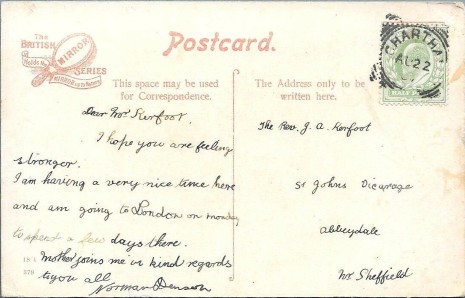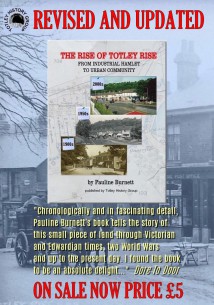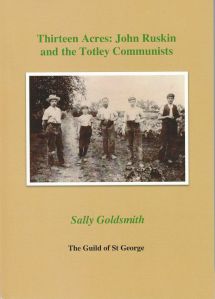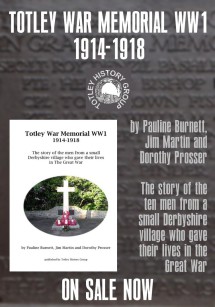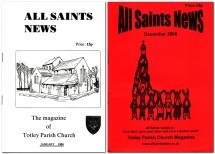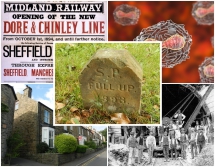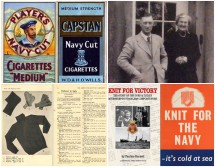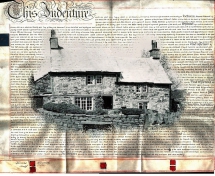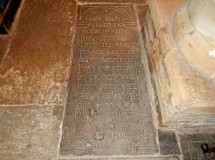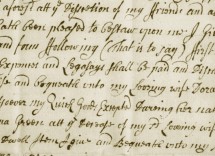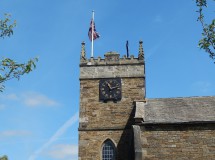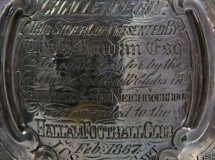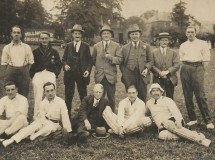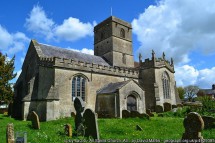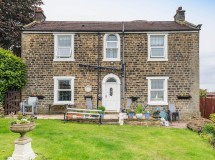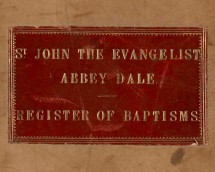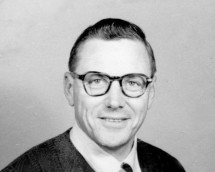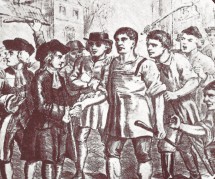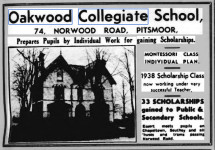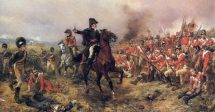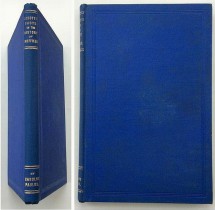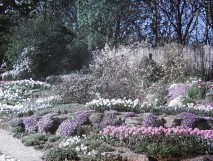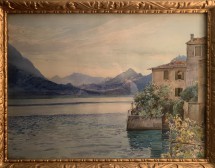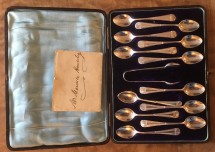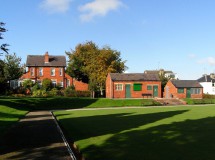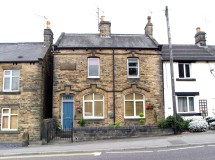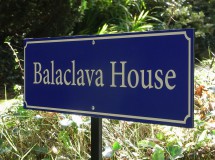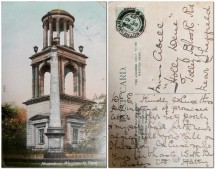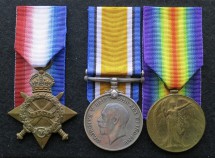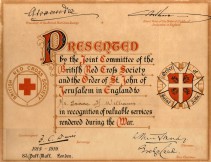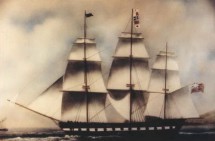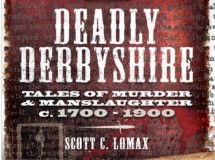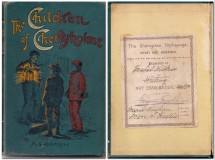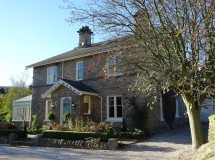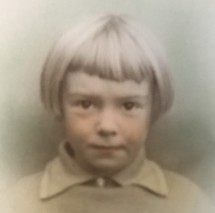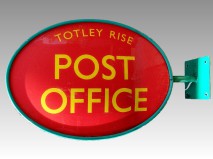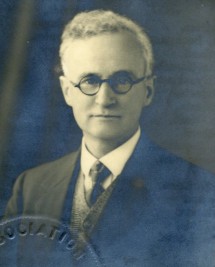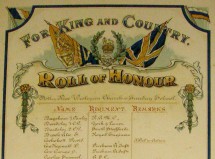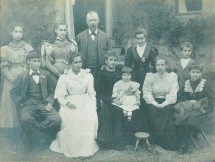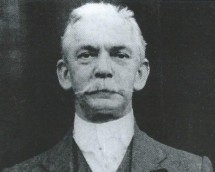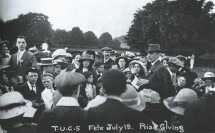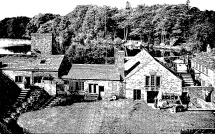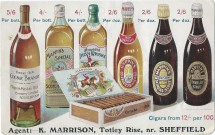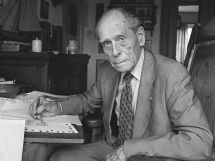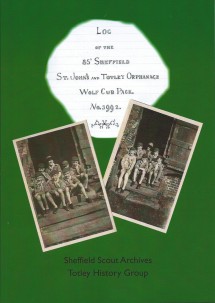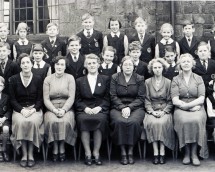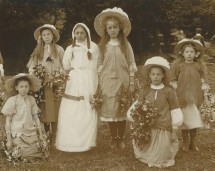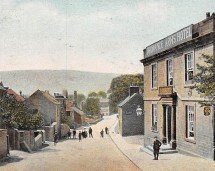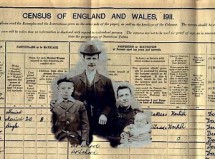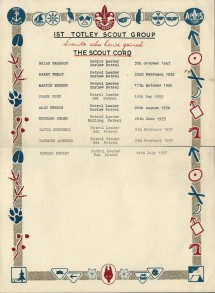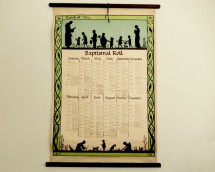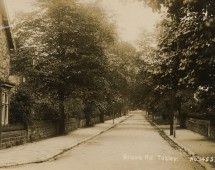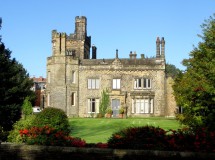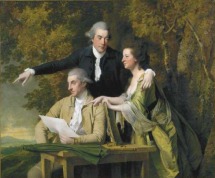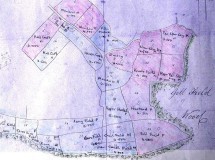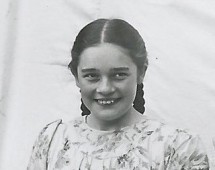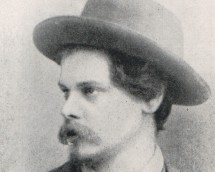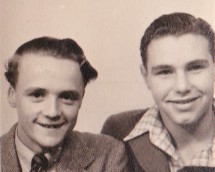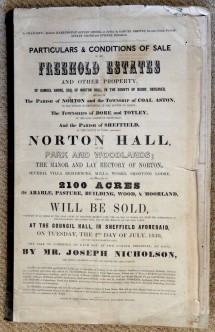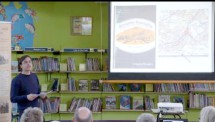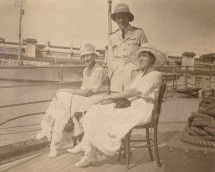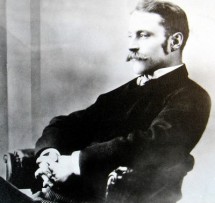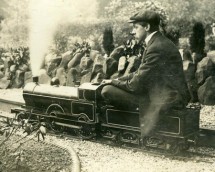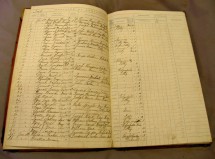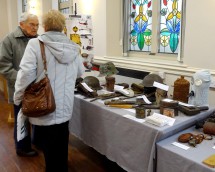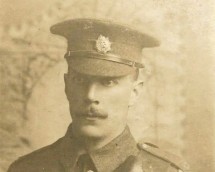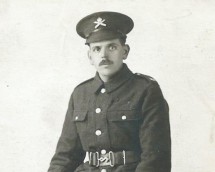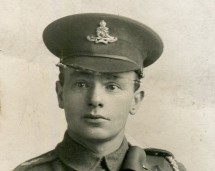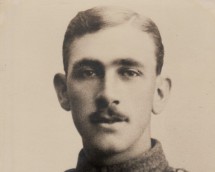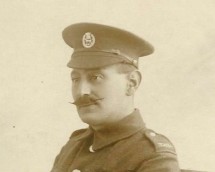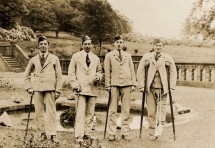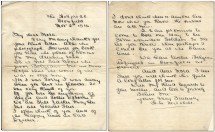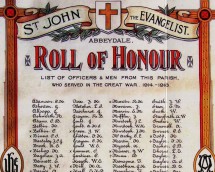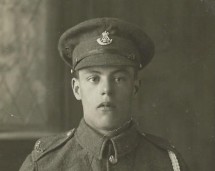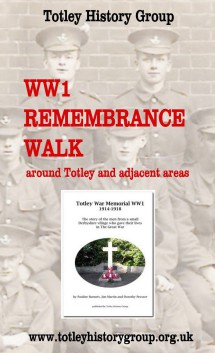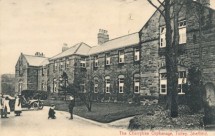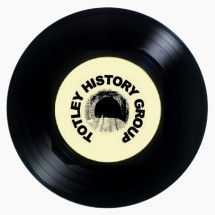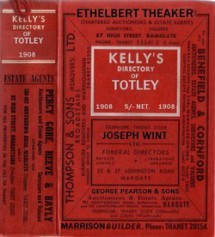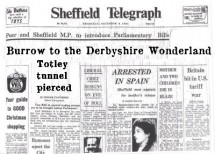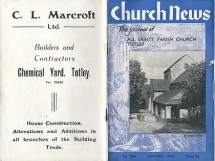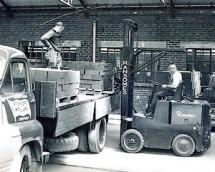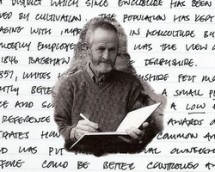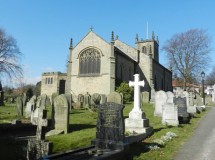WW1 Roll of Honour - The Survivors A-E
Please see War Memorials and Rolls of Honour for the names of local WW1 soldiers and links to other soldier's stories.
Cyril Bernard Adams
Cyril Adams was born in Sharrow, Sheffield in 1893. His father was Ernest Adams who was born in Sheffield in 1867, the sixth of twelve children of Henry Adams and his first wife Rebecca Adams who married on 22 March 1857 in Sheffield Parish Church. Cyril's mother was Letitia Martha Clayton who was born in Nottingham in 1864, the first of nine children of Rev. Alfred Clayton, a Primitive Methodist Minister, and his wife Mary Ann Brown who married in Retford, Nottinghamshire in 1862.
Cyril's grandfather, Henry Adams, was the son of a miner who had been sent to work on a pit bank at the age of seven and by the age of twelve was working down a coal mine. In 1863 he took up an offer of an agency for the Refuge Friend in Deed Life Assurance and Sick Fund Friendly Society which had been founded in Dukinfield, Cheshire in 1858. Henry developed the business opening a branch in Sheffield in 1869 and recruiting further agents throughout south Yorkshire. The company rewarded Henry by making him a director of the company whose name had been simplified to the Refuge Assurance Company.
Henry, who lived at West View 119 Psalter Lane, Sharrow, invited his son Ernest to join him in the company as a district inspector. Ernest married Letitia Clayton on 10 June 1890 at the Methodist Chapel, Retford. They made their home at 245 Cemetery Road, Sharrow. Their first child, Alfred Ernest, was born in 1901 but he lived for less than a year. Cyril was their only other child, born on 24 October 1893. The were still living in Cemetery Road in 1901 but following the death of Henry Adams on 12 December 1906, the family moved to Crabtree Lodge, 273 Barnsley Road, Pitsmoor.
They were still in Pitsmoor in 1911. After leaving school Cyril become an insurance clerk for the Refuge and began to work his way up the ladder. Unfortunately Cyril's war service record has not survived and his medal card cannot be distinguished from those of similarly named men. The next we hear of him is on 11 December 1917 when, by special licence, he married Eileen Patricia Walsh at St Joseph's Roman Catholic Church, Highgate Hill, Middlesex. Eileen was born in Highgate on 25 January 1892, the third of seven children of of Thomas Walsh, a civil servant, and his wife Mary Reidy who had married in County Clare, Ireland before coming to London in 1891.
Cyril and Eileen had a daughter, Teresa, on 3 December 1919 when they were living with Ernest and Letitia at Green Oak House, Totley. Ernest was a Justice of the Peace for many years and President of the Sheffield Free Church Council. After leaving Greenoak House he and Letitia lived at Surrey Lodge, 44 Dore Road whilst Cyril and his family were at nearby Naarden, Victor Road. Cyril died on 25 May 1948, aged 54. Eileen never remarried and died at the Claremont Nursing Home, Fulwood on 2 December 1964 aged 72.
Cecil Harrald Adamson
Cecil Harrald Adamson was born on 8 April 1894 in Sunderland, County Durham, to Ebenezer Adamson and his wife Florence. They later had another son, Donald Harrald Adamson, who was born in Sheffield on 18 September 1903.
Ebenezer Adamson had been born in Sunderland on 9 September 1867 to Robert Adamson, a blacksmith, and his wife Elizabeth. In 1881, he was a 13-year-old building society clerk living in his father’s household at 56 Lawrence St, Bishop Wearmouth. However, by 1891 he had risen to be the manager of a steelworks; his address at that time is not known as he was recorded on census night as a visitor in the household of Ann Ingleby, widow, at Spring Grove Terrace, Burley, Headingley with Burley, Leeds. Later in 1891, Ebenezer married Florence Newcombe Harrald, a schoolmistress who had been born in Sunderland in 1868.
By 1901, Ebenezer, Florence and Cecil had moved to Ecclesall, living at 10 Hardwick Crescent, off Psalter Lane, and in 1911 they were living in a large house at 23 Priory Road, off Sharrow Lane. Ebenezer described himself as a metallurgist (iron and steel); Cecil, now 16, was a clerk to an iron and steel merchant.
In 1913, Ebenezer seems to have applied for membership of the Institution of Mechanical Engineers, being proposed for membership by Joseph Adamson of Hyde, and supported by, amongst others, Daniel Adamson; it is not clear whether these were relatives. Ebenezer had apparently undertaken research in Chemistry and Metallurgy at Sheffield University between 1898 and 1902, and had worked as a consulting metallurgist and consulting metallurgical engineer from February 1901. At the time of his application in 1913, he was a Consulting Metallurgical Engineer of 18 York Street, Sheffield, and 19 St Vincent Place Glasgow. His application for membership appears to have been rejected because he had no training in mechanical engineering.
By 1913, the Adamsons had moved to Dore: White’s Directory for 1913 gives Ebenezer’s home address as Lilburn, Dore Road, Dore (now number 28). Cecil appears to have joined the Army relatively soon after the outbreak of World War 1, as he left Britain with his regiment on 23 September 1915, presumably having undertaken at least some training before he left. He gave his home address as Lilburn, Dore – his parents’ home, and his occupation in civil life was said to be with Wm. Jacks and Co, 19 St Vincent, Glasgow or 18 York Street, Sheffield – the same addresses as given by his father in his application for membership of the Institution of Mechanical Engineers.
Twelve days before he left Britain, Cecil married Olive Runa Bibbings in Ecclesall. He then left for Gallipoli, entering that theatre of war on 14 October 1915; he was therefore eligible for the 1914/15 star as well as the Victory and British War Medals. His medal record states that served first in the Royal Irish Rifles - although his service record suggests that he was actually in the 6 th Battalion, the Royal Irish Fusiliers. He later became a Second Lieutenant in the West Yorkshire Regiment. After Cecil went abroad, Olive went to Plymouth to stay with her parents. Cecil named her as his next of kin, and gave his address as The Cottage, Mount Gould, Plymouth – presumably her parents’ address.
Cecil appears to have been transferred to the RFC by 15 February 1917, when he was made a Lieutenant. He was in 31 Squadron, and subsequently served in the RAF following its formation in 1918. He was demobilised on 1 June 1919, and travelled to Plymouth to meet Olive, only to discover that, earlier that year, she had borne an illegitimate son, fathered by an American serviceman. He sued for divorce, and the decree nisi was awarded on 4 February 1920, when Cecil was again living on Dore Road.
After the war, Cecil’s career seems to have been similar to his father’s. The Yorkshire Post for 9 May 1925 stated that, on the previous day, at a meeting of the Iron and Steel Institute in London, Cecil H. Adamson of Sheffield, jointly with Gerald S. Bell of Lincoln, was awarded a Carnegie Scholarship of £50 to continue research on cast-iron transverse test bars and engineering formulae. By January 1933, he appears to have moved to 2 Hilton Road, Leeds.
He later moved to London, where in 1936 he married Letitia Moreira. In 1939, they were living at 82A Alexandra Road, Hampstead. Cecil worked in sales, and Letitia was a despatch clerk. Cecil’s mother had died on 11 November 1932, when her address was given as 111 Manchester Road, Sheffield. His father, Ebenezer, died in 1937 at the age of 69; as his death was recorded in West Hampstead, he may have been living with Cecil at the time. Cecil himself died in 1972. Olive remarried in 1924, and continued to live in the south west. She appears to have died in 1954.
George Allsop
George Allsop was born in Totley Rise in 1898. His father was Samuel Crofts Allsop who was born in Milford, Derbyshire on 30 March 1865, the first of twelve children of George Allsop, a licensed victualler, and his wife Elizabeth Crofts who married on 11 February 1865 at St. Mary, Nottingham. George's mother was Ada Martha Greenall who was born on 12 April 1862 in Liverpool, the only child of Joseph Greenall, an engine driver, and his wife Elizabeth Peak who married on 8 June 1856 at St. Mary, Prescot, Lancashire.
George's parents married on 11 August 1892 at Sheffield Parish Church. Samuel Allsop was a clerk with the Midland Railway. Their first child, Dorothy, was born on 30 April 1893 in Pitsmoor but the the family then moved to Totley Rise where George was born on 23 February 1898. In the 1901 Census the family were living on (Queen) Victoria Road. A second son, Harry was born on 6 October 1901. Being in Derbyshire the children were sent to Dronfield Grammar School travelling by train from Dore and Totley Station. Dorothy had become a student teacher by 1911, having been admitted to Sheffield Pupil Teacher Centre on 29 August 1910. Samuel was then a railway canvasser, responsible for promoting the railway's various services to businesses customers.
On 16 April 1913 George was singled out for special praise by the headmaster at the Dronfield Grammar School speech day for obtaining a second class honours in the senior examination at the age of 14 - "quite a phenomenal feat." After school, George went to Sheffield University where he joined the Officers' Training Corps. In September 1915 he was made a Second Lieutenant in the 8th Battalion of the Sherwood Foresters (Notts and Derbyshire Regiment).
George was seconded to the Royal Flying Corps on 15 March 1917 and after a period of training he became an observer. He was promoted to Temporary Lieutenant on 1 September 1917 and confirmed to Lieutenant on 28 January 1918. He qualified at a pilot and was posted to number 33 Squadron as a Flight Officer on 13 March 1918. George remained with the RAF until his discharge on 25 April 1919 when he returned home to Totley Rise.
During the war, George's younger brother Harry had been a popular member of a group of artists who entertained the troops in local military hospitals, including several concerts at St. John's VAD in 1915 and 1916. Sister Dorothy received her degree from Sheffield University in June 1916. George had to wait until July 1921 before receiving his degree from the university.
In June 1928 Samuel Allsop retired from the service of the London, Midland and Scottish Railway Company and the following year George married Olive Mary Briddon at Chesterfield Register Office. Olive was born on 20 March 1899 in Chesterfield, the only child of George Henry Briddon, a printer, and his wife Gertrude Hallowes who had married at Holy Trinity, Chesterfield in 1898. Olive was a widow having previously married Charles Marsden at St. Mary and All Saints, Chesterfield in 1918 but Charles had died in 1928.
In 1939 George and Olive were living at Brookside, Bakewell. George was a research physicist in the mining industry. In later life they went to live at Five Acres in Truro, Cornwall. They both died in 1986, Olive on 21 March aged 87 and George on 30 June aged 88.
Reginald Walter Rowden Ashworth
Reginald Ashworth was born in 1890 in Wilmslow, Cheshire. His father was Walter Ashworth who was born in 1850 in Crompton, Lancashire the eldest of four children of John Ashworth, a cotton spinner, and his wife Deborah Ashworth (no close relation) who married on 16 June 1850 at St Mary's, Oldham Lancashire. Reginald's mother was Margaret Ann Greaves who was born in 1846 in Crompton, the youngest of six children of Emanuel Greaves, a blacksmith, and his wife Hannah Nield who married on 12 June 1837 at Middleton, Lancashire.
Reginald's parents married on 23 May 1872 at Milnrow, Lancashire. At the age of seven Walter Ashworth was removed from school to become a "half-timer", assisting his father as an operative cotton spinner. When aged twelve he obtained a doctor's certificate permitting him to work the same hours as a man. This was during a difficult period for the Lancashire cotton industry which had supported Abraham Lincoln in his stance against slavery even though a blockade of the Southern states meant drastically reduced supplies of cotton reaching the ports of Liverpool and Manchester. Walter was still working as a cotton spinner at the age of 21 when he married Margaret. However, he was a noted bookworm and from an allowance of 6d. a week he had assembled a library of books and was largely self-taught.
By 1880 he had mastered shorthand and become the editor of a weekly journal. In the 1881 Census Walter and Margaret were living in Manchester at 15 Caistor Street, Chorlton-on-Medlock. Walter had become an active campaigner for the Conservative Party, acting as their agent in elections. He was offered a choice of three constituencies at the 1885 Parliamentary election and chose Chester-le-Street because Durham had a reputation for being the most radical in the country. He addressed at least seventeen meetings of electors. A most accomplished and entertaining speaker, he was noted for his ability to deal with hecklers in a way that invariably raised roars of laughter from the audience. He lost that election but he became a councillor and an agent for the Conservatives at other elections. For a while he was the secretary to Sir Ellis Ashmead-Bartlett who was the Civil Lord of the Admiralty under Lord Salisbury's government and M.P. for Ecclesall from 1885 until his death in 1902.
Reginald was Margaret and Walter's only child born on 3 April 1890. In 1892 the family were living in Barrow-in-Furness, Lancashire where Walter was the editor of the Barrow Herald. By 1894 they had moved to Blackpool and in the Census on 31 March 1901 the family were recorded at Sunningdale, Warbreck Drive, Bispham. Walter was still working as a journalist. Reginald became a pupil at Bispham Endowed School. When the family moved away from the area they continued to own the house in Blackpool which they rented out. In the next census in 1911 they were living at 44 Rock Park, Rock Ferry on the Wirral. Walter's occupation was recorded as a Conservative organising agent.
It would seem that by 1915 Reginald had become an articled clerk to a firm of solicitors in Sheffield, perhaps through the connection with Sir Ellis who was himself a barrister. Reginald married Amy Helen Sheppard at St. John the Baptist, Abbeydale on 12 June 1915. Amy was born in Heeley on 29 April 1892, the first of seven children of Thomas Sheppard, a school master, and his wife Rhoda Bailey who married in 1890. Amy had been a typist in a steel manufacturer's office before her marriage. She lived at 11 Millmount Road, Meersbrook in 1911.
We know very little about Reginald's time during the war as his service record has not survived. In November 1915 he was a canvasser for the Ecclesall district, under Lord Derby's recruitment scheme to attract volunteers for the Sheffield City Battalion of the York and Lancaster Regiment. Reginald, however, became a Chief Motor Mechanic in the RNVR (Royal Naval Volunteer Reserve). He was later awarded the Victory Medal and British War Medal by the Navy.
After the war, Reginald continued to pursue his legal career. He and Amy were living in Chorley at 36 Stump Lane when their daughter Isobel Marjorie was born on 23 February 1921. She was to be their only child. The following year Reginald received a Bachelor of Laws Degree from the University of Manchester and in December 1922 his name was published on a list of successful candidates in the final examinations of the Law Society.
By 1924 Reginald had become a partner in the law firm of Walker and Ashworth which had offices at 8 Spring Bank, New Mills, Derbyshire. The family, however, lived at Brabyn's Brow, Marple in Cheshire. Reginald was still working as a solicitor in New Mills at least until the start of World War Two and probably beyond. In the National Register compiled on 29 September 1939, whilst Amy was still at Brabyn's Brow, Reginald was recorded at 5 Station Road, Marple. Amy died on 23 January 1945 at Manchester's Royal Infirmary, aged 52.
Reginald remarried the following year in Scarborough to Jean Fraser Darling Scorgie. Jean was born on 20 November 1892 in Greenock, Renfrewshire, the first of three children of John Spence Scorgie, a railway clerk, and his wife Margaret Bell McDonald who married in Greenock in 1891. Jean was a masseuse who in 1930 whose name had been on the same passenger list as Reginald on a voyage to New York and again in 1935 on a trip to Tangier. In 1939 Jean was living at the Crawford Private Hotel, Crown Terrace, Scarborough under the name Jean Ashworth.
Jean and Reginald made several trips abroad together after the war. In the early 1950s they lived at 44 Kings Road, Cheltenham and were still there in November 1956 when the embarked at Southampton aboard the Antilles for a round the world cruise. It was perhaps to celebrate Reginald's retirement as a solicitor because their address on the incoming passenger list the following month was now Audley Road, Alsager, Cheshire. In later life, Reginald returned to Blackpool where he and Jean lived at 74-76 Vicarage Lane, Marton. They both died there in the spring of 1979. Reginald was aged 89 and Jean aged 86.
Geoffrey Atherton
Geoffrey Atherton was born Geoffrey Albert Augustus Ely on 3 October 1884 in Horseheath, Cambridgeshire, close to the county borders with Suffolk and Essex. His mother was Flora Kate Ely, a single woman, born in 1868 in Horseheath, the youngest of three children of Richard Ely, a gamekeeper, and his second wife, Ann Osborn, who married in 1861 in the Linton district of Cambridgeshire. Flora married Martin Atherton on 5 June 1890 at St. Mary, Shudy Camps, Cambridgeshire. Martin was born in Horseheath in 1865, the third of six children of Charles Atherton, a publican, and Sarah Radford who married on 3 January 1862 in Ashdon, Essex.
In the Census of 1891, Martin, Flora and Geoffrey were living in Horseheath. Martin was an agricultural labourer who appears to have moved around to find work. Later that year they moved to neighbouring Shudy Camps where their first child, Roger, was born. Another son, Joseph, was born in 1893 but he died the same year. The Atherton family moved again to Hanchet End, just across the county border into Suffolk, where another son, Thomas, was born in 1896. Daughter Lily was born in 1889 after the family had returned to Shudy Camps.
In the next Census in 1901 the Atherton family were living at Glebe Farm, Great Thurlow, Suffolk where Martin was working as a horse-keeper and Geoffrey, aged 16, was a stock-keeper. Another son, Frederick John, was born there later that year. The Atherton family had returned to The Green, Horseheath by 15 March 1909 when Thomas, Lily and Fredrick were admitted to the Horseheath Junior Middle Infants School. The school admissions register shows that all three children had been pupils previously at Great Thurlow. In the 1911 Census, Martin's occupation is recorded as a steam traction engine plough man. Thomas was a farmyard boy and Lily and Frederick were still in school.
Geoffrey was still using the surname Ely up to 1901 but he joined the Suffolk Regiment as Geoffrey Atherton when he attested at Bury St. Edmunds on 21 October 1902 at the age of 18. He gave his civilian occupation as labourer. He enlisted for three years in the regular army plus nine years in the reserves. For his first five years of service he was stationed on the Home Front. He was promoted to Lance Corporal on 12 Oct 1907 and posted to Malta from 20 November 1907 until 3 October 1910 when he returned to Britain. Then with the Reserves he appears to have been working as a chauffeur in Old Bolingbroke, Lincolnshire when the 1911 Census was taken.
Geoffrey married Ellen Nellie Reynolds on 28 October 1913 at St. Peter, Heeley. Nellie was born Nellie Cowell Reynolds on 18 February 1886 at Shudy Camps, the daughter of Alice Reynolds, single woman. Alice was born on 4 May 1868 Shudy Camps, the only daughter of John Reynolds and his wife Martha Challis who married at St. Mary's in 1865. Nellie was raised by her grandparents who were next door neighbours of the Athertons when they lived in Shudy Camps. Geoffrey and Nellie had a son, Victor Jack, born in Totley on 1 May 1914. When he was baptised at Christ Church, Dore on 12 September 1915, the parish register recorded an address of Brook Terrace, (Mickley Lane). By then, however, his father was at the Front in France.
Shortly after war broke out, Geoffrey was recalled to the Colours. He was promoted to Acting Sergeant with the 3rd Battalion on 3 September 1914 and sent to France with the British Expeditionary Force on 7 October 1914. On 20 March 1915 his rank was confirmed when he was posted as Sergeant to the 2nd Battalion. In October 1915 he received a gunshot wound to the right arm and on 7 October was invalided back to Britain. He was posted back to the 3rd Battalion on 12 November and discharged from the army on 19 November 1915.
However, that was not the end of Geoffrey's war. After recovering from his gunshot wound, he enlisted in the 43rd Squadron of the Royal Flying Corps on 11 June 1916. He was engaged as a motor transport driver, having been a tractor driver in civilian life. Geoffrey gave his home address as 2 Pashley's Cottages, Woodhouses, Sheffield. In addition to young Victor, he also listed a second child Ruby, born on 3 November 1911 in Winton (Linton). Ruby's birth was registered as Ruby Reynolds.
Geoffrey was promoted to Corporal on 1 February 1917 and promoted again to Sergeant on 1 October 1917. He transferred to the RAF with its creation on 1 April 1918. He was posted to Berlin on 24 April 1920 and appears to have been in Germany until 16 January 1922 when he returned to Britain and to 28 days leave. He was discharged on 6 March 1922 on termination of his period of engagement, giving his intended address as Castle Camps, south Cambridgeshire.
A son, Eric Leslie, was born towards the end of 1922 and another son, Charles on 13 January 1924. In 1939 Geoffrey enlisted in the RAF Reserve for a period of four years and he appears to be absent from the 1939 National Register. Nellie and son Charles were living at Camp's Hall Cottages, Sawston, close to Duxford airfield in Cambridgeshire. With them was Clara Emma Rowling, the widow of Samuel Webb Cowell, a horse-keeper from Castle Camps. Might he have been Nellie's father? Ruby and Victor were both married and living elsewhere in south Cambridgeshire. Eric Atherton was killed on 7 January 1943 when serving as a driver with the 18th Water Tank Company.
It appears that Geoffrey lived for the rest of his life in Cambridgeshire. He and Nellie were living at Fair View, Horseheath when he died at the age of 71 in Addenbrookes Hospital, Cambridge on 13 March 1956. Nellie never remarried and continued to live at Fair View until her death on 18 January 1970 at the age of 83. They are both buried at All Saints Churchyard, Horseheath.
Geoffrey's younger brother Thomas Atherton was a Private in the 14th Company of the Machine Gun Corps in the 10th Suffolk Regiment. He was killed on 19 November 1916, the last day of the Battle of
the Somme, aged 20.
John Ainley Bagshaw
John Ainley Bagshaw was born in Heeley on 25 July 1894. His father was Joseph Herbert Bagshaw who was born at Spinkhill, Eckington in 1823, the eighth of ten child born to Joseph Bagshaw, a grocer and provisions dealer, and his wife Jane Healey who married at Littlemoor Chapel, Glossop in August 1852. John's mother was Fanny Ainley who was born in 1868 in Golcar, near Huddersfield, the youngest of four children born to Seth Ainley, a woollen manufacturer and his wife Ann Sykes who married at Slaithwaite on 17 October 1855.
Joseph Herbert Bagshaw became an printer and engraver. After his marriage to Fanny at the Baptist Chapel, Golcar, on 5 October 1893 the couple made their home in Sheffield, where John was born the following year. Sadly he was to be their only child as Fanny died on 28 October 1898. In the 1901 Census Joseph Herbert was living at 80 Ashland Road but young John was in Spinkhill with his father's older sister Mary Hellen and her husband George Hunt who had taken over the family grocery business after the death of John's grandfather.
In the summer of 1901, Joseph Herbert Bagshaw remarried to Edith Peggs, in Tendring district, Essex. Edith had been born in Brightlingsea in 1878, the youngest daughter of Cornelius Peggs, a ship chandler, and his wife Martha Whisson who had married in Lexden in 1866. Joseph and Edith had a daughter, Bessie, born in Sheffield in 1903. Whilst Joseph's business remained at Eyre Street, Sheffield, the family home moved to Springfield, 8 Totley Brook Road. A son, Joseph Rowland, was born there in 1907 and they were still there in 1911 when the Census was taken.
John, now aged 17, was absent from that Census and we have so far been unable to find him. Possibly he was away at college or even abroad - John and two friends gave a lecture and slideshow about Austria to the Union Church Literary Society in December 1913. By that time the Bagshaw family were living at a house on Totley Brook Road they named Wyvenhoe, after the village in Essex. Its number is yet to be traced.
John Ainley Bagshaw enlisted at the start of the war. Like so many others, John's service record has not survived. Brief details recorded on a medal roll index card tell us that he had joined the Royal Army Medical Corps as Private number 178. He was sent to France with the British Expeditionary Force on 15 April 1915 and, having survived the war, was disembodied on 12 April 1919. He was awarded three medals: the 1915 Star, the British War Medal and the Victory Medal.
After the war John became a transfer maker for marking steel, we presume in his father's business. On 30 June 1921 he married Ethel Mary Bell, an Inland Revenue clerk, at Ranmoor Wesleyan Chapel, Upper Ranmoor Road. Known as Molly, she had been born in Sheffield on 31 October 1897, the younger daughter of John Edwin Bell, a commercial traveller, and his wife Mary Jollie who married in Sheffield in 1890.
In 1925 John's father Joseph Herbert Bagshaw died in mysterious circumstances. On the morning of 18 October he had been seen walking along Totley Brook Road presumably heading towards the Millhouses tram stop on his way to work but had subsequently gone missing. On 6 October a body was found in Ecclesall Woods which was too decomposed to identify but, from articles on the body, was presumed to be Joseph. A razor in a case and a bloodstained mackintosh were found near the body and Joseph's son John Henry Bagshaw testified that he thought it probable that his father had committed suicide as he had been very depressed and worried about letters he had received recently from the Inland Revenue. However, the coroner was unable to determine the cause of death and so advised the jury to return an open verdict which they duly did.
John and Molly appear to have had three daughters, Sheila in 1924, Joyce in 1927 and Judith in 1932 although the two younger children's records are redacted from the 1939 National Register when
the family were living at 90 Ashdell Road, Broomhill. John Ainley Bagshaw died at home at 10 Canterbury Crescent, Fulwood on 31 October 1957 - his wife's 60th birthday - aged 63. Molly Bagshaw, of 20
Broomgrove Road, Broomhall, died on 20 May 1990, aged 92.
Tom Bainbridge
Tom Bainbridge was born in Totley on 11 March 1895. His father was Benjamin Bainbridge who was born in Monyash, Derbyshire in 1847, the fourth of eight children of Benjamin Bainbridge senior, a farmer and livestock dealer, and his wife Elizabeth Hawley who married at Bakewell Parish Church on 5 April 1836. Tom's mother was Clara Bramwell who was born in Taddington, Derbyshire in 1867, the fourth of eight children of Elias Bramwell, a road labourer, and his wife Mary Ann Stone who married at Bakewell Parish Church on 30 December 1861.
When Tom's parents married on 29 December 1896, it was Benjamin Bainbridge's second marriage. He had married Sarah Jane Smith, the widow of his elder brother Thomas, in Manchester in 1886. A daughter Elizabeth was born in Monyash on 7 April 1887 but Sarah Jane died the following December. Benjamin had then lived with Clara Bramwell as man and wife and they had three children before their marriage. Sarah Ann (1890) and Benjamin (1892) were born in Monyash before they moved to Totley Rise where Tom was born in 1895. Soon after their fourth child Edith had been born, Benjamin died aged 4 and was buried at Christ Church, Dore on 24 May 1897. Four more children arrived soon after: John William (1899), twins Laura and Sarah (1903) and finally Louisa (1905). All of the children were baptised at St. John the Baptist, Abbeydale. However, their parents married at Christ Church, Heeley giving an address of 75 Alexandra Road although it appears that they never left Totley Rise. Benjamin was a carter when he first came to live here but later he worked as a brickyard labourer.
The children were sent to Totley Church School. Tom was admitted on 11 April 1899 at the age of 4 and stayed until 1 June 1906 when the register shows that he left to attend another, unnamed, school. All of the surviving seven children were still living at home at 23 Baslow Road, Totley Rise in the 1911 Census. Benjamin, now aged 64, was a gardener. No occupation is recorded for Tom, aged sixteen so he may well have been still at school. Their half-sister Elizabeth had married Joseph Bunting, a labourer, at St. James's Church, Buxton on 14 December 1907 and given birth to three children, one of whom had died in infancy. By 1911 she was widowed and living with her two surviving sons, George and Joseph in Bakewell Union Workhouse.
In October 1914, at the start of hostilities, The Star Green 'Un reported that Tom Bainbridge was a fine defender who played for Totley Brook F.C. His military service record has not survived and if there are records of his service medal awards they cannot be identified from those of similarly named soldiers. Tom married Isobel Annie Smith in Ecclesall Bierlow district in the Spring quarter of 1918. Isobel was born on 25 July 1897 at Derby Hills, Derbyshire, the sixth of seven children of Alvin Smith, a coachman, and his wife Hannah James who married at Ticknall Parish Church on 11 August 1881.
When Ethelbert Theaker retired in the late 1920s, Tom and Isobel took over the newsagent and tobacconist shop at 15-17 Baslow Road. Joan Sutton remembered that Tom ran a penny-a-week lending library. During the Second World War, when Tom was in his forties, he took a second job working night shifts in a munitions factory, perhaps to ensure that would remain at home should the upper age limit for military service be raised.
Tom died on 22 July 1946, aged 51. He was buried at Christ Church, Dore three days later. In her autobiography, Dorothy Trott said that she felt the extra effort of running the shop during the day and working in the factory at night led to his early death. For a while afterwards Isobel ran the shop on her own, delivering the heavy newspapers and periodicals herself. Then in the late 1940s the shop was sold to Robert Topham and Isobel moved to a bungalow at 114 Baslow Road. She worked for many years for Miss Trott as the housekeeper to Dore and Totley High School. She and Tom had not had children and she enjoyed the company of the schoolchildren. Isobel died at the Royal Hospital, Sheffield on 13 December 1963, aged 66.
John Cameron Gordon Bardsley and David Crawford Gordon Bardsley
Cameron Bardsley and his younger brother David appear on the Rolls of Honour at both Totley Rise Methodist Church and at Abbeydale St. John the Baptist. David also appears on the Roll of Honour of his employer, Arthur Balfour & Co. Ltd., at Kelham Island, Sheffield.
John Cameron Gordon Bardsley was born in Matlock, Derbyshire in 1893. His father was John Burton Bardsley who was born at Ashton under Lyne, Lancashire in 1862, the second of seven children of Joseph Bardsley, a brush manufacturer, and his wife Elizabeth Burton who married at the Methodist New Connexion Chapel, Ashton on 7 September 1858. Cameron's mother was Janet Gordon who was born in Carlisle, Cumberland in 1862, the eldest of six children of Pastor John Henry Gordon, a Baptist minister, and his Scottish wife Janet Cameron Crawford. It would appear that Cameron's parents met whilst they were both living in Hackney, Middlesex. His father was working as an accountant and his mother as a Board School teacher. They married at the Congregational Church in Darlington, Durham on 1 June 1892.
John and Janet Bardsley made their home at Rockside, located at the "summit" of Matlock Bank. Cameron was born there on 20 April 1893. Rockside Hydro was a pleasure and health establishment that could accommodate about 100 visitors, with baths, tennis courts, bowling greens, billiards rooms, dining rooms etc. and about 70 bedrooms. It had been built in 1862 by Charles Rowland and at first John became Mr Rowland's manager. In December 1893, however, a new company, Rockside Hydropathic Limited, was formed to purchase the hydro from Mr. Rowland and to expand its facilities. John became its managing director whilst Mr. Rowland became a director as well as its main shareholder.
A second son, David Crawford Gordon Bardsley was born at Rockside on 23 September 1894. By 1900, however, the Bardsley family had moved to Dore where Douglas William Gordon Bardsley was born on 7 December. In the census on 31 March 1901, the family were recorded at Glenroyd, 5 Grove Road. John was now the company secretary and chief accountant of Davy Brothers Limited, at their Park Iron Works, Foley Street, Sheffield. A fourth son, Ronald Francis Gordon Bardsley, was born on 22 June 1903. Cameron and David were educated at Dore High School and later at Chesterfield Grammar School. By 1911 the family had moved home to 82 Springfield Road, Millhouses.
Cameron Bardsley attended Sheffield University for six months in each of the years 1910 to 1913 whilst also pursuing an apprenticeship at Davy Brothers in the remainder of each year. He became an graduate member of the Institute of Mechanical Engineering on 7 July 1914. Later that year Cameron enlisted in the 12th (Sheffield) Battalion of York and Lancaster Regiment and on 15 May 1915 he was promoted from Sergeant to Temporary Second Lieutenant. Shortly after he was appointed the Battalion Signalling Officer. However, Cameron's military service was cut short in June 1916 when he was diagnosed as suffering from the heart condition tachycardia. He was formally discharged from service on 9 October 1916 and presented with Silver War Badge number 2957 on 15 November. By this time his parents had moved back to Totley Rise and were living at Sunnycroft, 2 King Ecgbert Road. Cameron returned to work for Davy Brothers for the remainder of the war.
David Bardsley was on the staff of Arthur Balfour & Co. Ltd. when in August 1914 he enlisted as a Private number 12/34 in the 12th Battalion of the Yorks and Lancashire Regiment. His service record has not survived but we know that he rose quickly to the rank of Lance Corporal and on 29 May 1917 he was discharged to a commission in the South Staffordshire Regiment. Second Lieutenant David Bardsley was awarded the Military Cross in October that year "for conspicuous gallantry and devotion to duty. He led the right flank of his brigade in an attack to the exact position of the final objective. He frequently exposed himself to heavy fire to take compass bearings." David was also awarded the British War Medal and Victory Medal.
Cameron Bardsley married Edith May Rolley at Christ Church, Dore on 16 June 1921. Edith was the only daughter of James Rolley, a grindstone merchant, and his wife Emily Alice Browne, who had married at St. Mary's Church, Sheffield on 23 September 1889. Two sons, James Edward and Francis had died in infancy. Edith was born on 7 May 1894 when the Rolley family were living at 100 Arundel Street but by 1901 they had moved to Glover Road, Totley Rise. By 1911 they had moved to Thornleigh, 100 Totley Brook Road where they would have been close neighbours of the Bardsleys. Cameron remained assistant outdoor engineer with Davy Brothers until 1925 when he became works manager for Guest and Chrimes Limited at their foundry and brassworks in Rotherham.
It would appear that Cameron and Edith did not have children and did not remain together. In the 1939 National Register, whilst Edith was shown as a poultry farmer at Cricket Hill, near Wokingham, Berkshire, Cameron was at 6 St. Catherine's Court, Acton, Middlesex living with Doris Jennie Irene Marrison, the widow of William Cowie. Cameron and Doris returned to Sheffield sometime after 1947 to live at 54a Wilson Road, Broomhall. Cameron died at the Royal Hospital Annexe, Fulwood on 30 May 1952, aged 59. Doris died in Broomhall on 23 February 1960, aged 62. Edith Bardsley died in Basingstoke on 24 February 1976, aged 81.
David Bardsley gave his occupation as steel manufacturer when he emigrated aboard the SS Baltic which sailed from Liverpool on 5 May 1920 bound for New York. He lived in Boston and later in Quincy, Massachusetts. When, on 5 June 1926, David arrived back in England aboard the SS Montrose he was accompanied by his wife Bertha Madeline Dunbar who had been born in Roxbury, Massachusetts on 13 March 1898. The couple gave their intended address as Sunnybank, the home of David's parents. The stay was a short one as they sailed from Glasgow aboard the SS Metagama bound for Montreal on 27 August. From there they made their way via Newport, Vermont to their home at 149 Farrington Street, Quincy. David was still working for Alfred Balfour as the treasurer of its American subsidiary, Arthur Balfour Steel Company Inc.
David and Bertha were living in New Orleans in 1930 when the US Census was taken. David gave his employment as a salesman for foundry products. They had returned to England by 1937. In 1939 they were living 44 Chatsworth Road and were still there when David died on 5 June 1940, aged 45. They appear to have had no children. Bertha returned to Massachusetts in 1947. She died in March 1968 at Mattapan, aged 69, and was buried at Cedar Grove Cemetery, Dorchester.
Albert Barnes and Charles Reginald Barnes
The Barnes brothers were both born in Bradway, Albert on 8 November 1894 and Charles on 3 September 1897. Their father was Samuel Barnes who was born in Crich, Derbyshire, in 1853 the sixth of eight children of John Barnes, a quarryman, and his wife Eliza Lambert who married on 19 July 1836 at Sheffield Parish Church. Their mother was Eliza Titterton who was born in Sheffield in 1857, the younger daughter of William Titterton, a spring knife cutler, and his wife Elizabeth Lambert who married on 30 March 1850 at Sheffield Parish Church. Although both grandmothers were named Lambert, they were not close relations.
When Samuel and Eliza married at Christ Church, Heeley on Boxing Day 1892 they were both widowed. It was Samuel's third marriage and Eliza's second. Samuel had had three children with his first wife, Elizabeth Slater, and one son with his second wife Mary Bennett. Eliza had one son with her first husband Thomas Barber. Only one of their combined five children, Eliza Barnes, had survived until adulthood but she had left home to work in domestic service by 1891. She married John William Potter on 12 November 1896 in Heeley.
Samuel and Eliza lived at Twentywell Lane, Bradway where a third child, Florence Mabel, was born in 1899. Samuel was a quarryman like his father and presumably he worked at the nearby quarry run by the Tinker Family who also owned the Castle Inn and the adjacent cottages. Samuel Barnes died in 1903 aged 51 and was buried at Norton Cemetery on 28 November. In the 1911 Census Eliza worked at home as a dressmaker whilst her two sons worked for a grocer, Albert as an assistant and Charles as an errand boy. Florence was still at school.
Very little information has survived about the brothers' war service. Albert's record cannot be distinguished from those of many similarly named men. Charles worked as a cutler before serving with the Royal Field Artillery during the war. He re-enlisted in Sheffield on 8 February 1921 for a further four years as a gunner and was finally discharged on 7 August 1925. He returned home to his mother and brother in Bradway, sister Florence having left home when she married Percy Seedhouse in 1921.
Eliza Barnes died in 1930, aged 74, and was buried at Norton Cemetery on 28 June. Charles married Alice Evelyn Ashby later the same year. Alice was born in Dore on 6 June 1903, the third of six children of Charles Bernard Ashby, a stonemason, and his wife Beatrice Sykes who had married at Christ Church, Dore on 20 January 1901. A son Roy was born on 17 February 1935. The 1939 National Register shows Charles, Alice, Roy and Albert living at 2 Castle Cottages, Twentywell Lane. Charles was a public works labourer and Albert a grocery shop manager. The adults would live at the same address for the rest of their lives.
Charles later became a contractor's electrician and Albert worked as a window cleaner. Albert was knocked down by a car in Abbeydale Road South on 23 November 1950. He was taken to Sheffield Royal Infirmary and died there from head injuries three days later. He was aged 56 and unmarried. Alice died at home on 14 January 1964, aged 62. Charles died on 9 September 1968 aged 71.
Ernest Bennett
Ernest Bennett was born in Sheffield on 5 April 1898. His father was William Pendle Bennett who was born in Rickinghall, Suffolk in 1855, the second of six children of George Bennett, a shoemaker, and his wife Caroline Williams who married on 1 June 1852 in St. Mary's Church, Redgrave, Suffolk. Caroline was a widow who had a daughter, Elizabeth, from her first marriage to Edward Flatman on 14 December 1844 at Roydon, near Diss, Norfolk. Ernest's mother was Mary Martha Ward who was born in Southery, Norfolk in 1861, the third of six children of Abraham Ward, a general dealer, and his wife Rachel Porter who married on 16 October 1856 at St. Mary's Church in Southery.
Ernest's parents married on Boxing Day 1877 in Southery. William was a shoemaker like his father and grandfather John Bennett. William and Mary had nine children in all but we have been able to trace only seven of them. Three were born in Southery: Violet Evangeline (1879), Theodora Martha (1881) and Frederick Benjamin (1886), all baptised at St. Mary's.
By 1891 the Bennett family had moved to Sheffield, living at 89 Abbeydale Road, Highfield. A daughter, Blanche, was born on 13 June 1892 and baptised at St. Andrew's Primitive Methodist Church on 12 July. Three more children were born in Sheffield: Edith Mary (1894), William (1896) and Ernest (1898). William died aged 4 months and Blanche died aged 8 years whilst the family were living at 80 Rockingham Street. They were buried in City Road Cemetery.
The Bennett family had moved to Totley Rise by the time the next census was taken on 31 March 1901. Violet was in service as a cook and Frederick had become a shoemaker, helping his father. He married Florence Hardy in Rotherham in 1910 and was a clog maker and dealer living at 136 Gleadless Road, Heeley in 1911. Theodora and Edith were together in service in Frencham, Surrey which left only Ernest, aged 12, still at home with his parents in Totley Rise.
After leaving school Ernest became a postman but then joined the Royal Navy on 16 January 1915. Initially he was stationed at HMS Ganges, a training establishment at Shotley near Ipswich. He was made a signal boy and by 15 April 1916 had been promoted to Ordinary Signaller on HMS Minotaur and promoted again to Signaller on the same vessel on 26 January 1917. After a short spell aboard HMS Skipjack, Ernest was wounded when the dredger HMS St. Dunstan was sunk by a mine from the German submarine UC-21 off Portland Bill. He had further spells aboard the Apollo, Blenheim and Victory I, before being discharged on 8 May 1920. Although his record says that he was unfit for further military service, his discharge was approved on compassionate grounds. His father had died the previous year and been buried at Dore Christ Church on 3 February.
On 21 September 1924 Ernest married Nellie Senior at St Mary's Church, Walkley. Nellie was born in Sheffield on 15 July 1897, the third of five children of John William Senior, a groom and cab driver, and his wife Annie Elizabeth Nell who married on Christmas Day 1889 at Owlerton Parish Church. The marriage register shows that Ernest was a clerk living at 246 South Road, Walkley. It would appear that Ernest and Nellie did not have any children.
In 1939 they were living at 112 Oldfield Road, Stannington and Ernest was employed as a clerk in the accounts section of Sheffield's Public Assistance Department (later known as the Social Welfare Department). He was an ARP warden during World War II. Ernest died at the age of 51 and was buried at Christ Church, Stannington on 5 September 1949.
Frederick Arnold Best
Arnold Best was born in Pitsmoor in 1896. His grandfather, John Best, was a file forger, and later a grocer, who lived at 123 Fitzalan Street, Pitsmoor (this street, which ran parallel to Rock Street, has since been demolished). John and his wife Jane had eleven children, of whom Arnold’s father, Frederick, born about 1867, was the fifth.
Frederick Best appears to have been ambitious. The 1881 census lists him as a coal merchant’s clerk, aged 14, and in 1891 he was a cost clerk in a steelworks. He married Caroline Davis in 1892, and their first child, Sydney Davis Best, was born on 8 December 1893, when the family was living at 118 Abbeyfield Road, in Pitsmoor. Sadly, Sydney died in 1895, the year in which Frederick joined the firm of Thomas Firth and Sons Ltd as head of the steel foundry department. Arnold, Frederick and Carline’s second child, was born on 14 May 1896 and baptised at Christ Church, Pitsmoor, on 7 September 1896.
At some time between July 1898 and 31 March 1901, the Best family moved to Abbeydale Rise, and by 1905 they had moved to Ringstead, 20 Dore New Road. Ringstead was a prestigious dwelling. The Sheffield Daily Telegraph for 15 March 1904 described the house, which was for sale by auction, as an ‘Excellent Family Residence’, stone-built, detached, with a carriage entrance, lawn, and shrubbery at the front, and a large kitchen garden, planted with fruit trees, at the back. The house was said to be in excellent condition, and ‘fitted with costly stoves and mantels’. It was at that time occupied by H. J. M. Cockayne, of the department store family.
In the 1911 census, Frederick, now 44, described himself as the director and secretary of a steel works. Caroline, his wife of 18 years, had borne him five children, two of whom had died – their first child Sydney, and Colin Davis Best, who was born in May 1898 and died aged 7 months. Their daughters, Kathleen Mary, aged 9, and Jean Margaret, aged 2, were at home on census night; Arnold was away at school in Cheltenham. Picture Sheffield has a photograph (Ref: y04703) of Frederick in about 1919, when he was Company Secretary of Thomas Firth and Sons Ltd.
Arnold, Frederick and Caroline’s oldest surviving child, was born on 14 May 1896. He was educated at New College, Harrogate (May 1907 to May 1910) and Cheltenham College (May 1910 to May 1912). From May 1912 to May 1913, he worked in the machine and engine test shops in Messrs Peugeot Automobiles, France, and then spent 15 months (from May 1913 to August 1914) in Germany. From October 1914 to October 1915, he worked in the workshops at Messrs Thos. Firth and Sons Ltd., Sheffield, and commenced evening classes in metallurgy in Sheffield University.
However, in October 1915, Arnold joined the Royal Naval Air Service as a Flight Sub-Lieutenant (service number 37373-37670) serving with the Airship Service. On 1th February 1916, he was awarded the Aeronaut’s (Balloonist) certificate. He was promoted to Flight Lieutenant in June 1917, and on 25 September 1917 he was awarded his Airship Pilot’s Licence. While with the RNAS, he took courses in engineering, aerostatics, internal combustion engines etc. He became a Captain in the RAF in April 1918. On 25 October 1918, he was sent for a course of instruction to RAF Cranwell (originally founded in 1916 as the Royal Naval Air Service’s Training Establishment, and taken over by the RAF on its establishment as a separate service in 1918). He was demobilised on 26 January 1919 and was awarded the Victory and British War Medals.
After demobilisation, Arnold returned to a career in engineering. He was elected an Associate Fellow of the Royal Aeronautical Society in October 1919, and in February 1920 he was proposed for graduate membership of the Institution of Mechanical Engineers. At that time, he was working as a pupil at Brown-Firth Research Laboratories Sheffield, and attending instruction in Iron & Steel and Mathematics at Sheffield University. He gave as his home address at that time The Terrace, Eyam, Derbyshire. He subsequently moved to London, where he was employed as an engineer.
On 1 September 1925, in St John’s Church, Roundhay, Leeds, Arnold married Alexandra Enid Ives, the daughter of Alfred Edward Ives, a Leeds business man who was for some time the proprietor of the Grand Restaurant, Leeds. Two of Alexandra’s elder brothers had died in the war: Kenneth Hill Ives, a 2nd Lieutenant in the West York Regiment (8th Battalion, the Leeds Rifles – a territorial battalion) died of pneumonia and typhoid in York Military Hospital in December 1914 aged 22, and Derrick, a Sub-Lieutenant on the submarine H10, died aged 21 when his vessel was lost in the North Sea on 19 January 1918. A third brother, Edward Leslie, served as a 2nd Lieutenant in the West Yorkshire Regiment and as a Captain in the Royal Flying Corps, and survived the War.
In 1939, the Bests were living in Hadresham, Surrey; Arnold was the company director and sales manager of an aluminium light metal works. Alexandra died in Outwood, Surrey on 2 September 1950 aged 49; Arnold survived her and appears to have died in Roquebrune-Cap-Martin, near Monte Carlo, on 7 December 1968 aged 72.
Lawrence Ernald Bindley
Lawrence Bindley was the son of Ernald and Frances Bindley, of Rose Villa, Totley Brook Road. Like his father, John Riles Bindley, Ernald Edward Bindley was born in Ashby-de-la-Zouche in Leicestershire. In 1840, John, a leather merchant who had been born in about 1807, married Harriett Wood, who had been born in Gibraltar in about 1814. They had at least ten children, all born in Ashby-de-la-Zouche; Ernald, born in about 1850, was the seventh. He did not follow in his father’s trade but became a cashier with the Sheffield Banking Company.
Frances Dora Walker was born in Sheffield in 1858. Her father, James Charles Thrasher Holworthy Walker of 344 Glossop Road, described himself as a Professor of Music; his father, James Walker, was a surgeon and general practitioner. In 1855, James junior married Eliza Anne Ward, the daughter of Henry Huntsman Ward, an edge-tool manufacturer who had died in 1831. They had two sons and two daughters. Sadly, James junior died in 1881; Eliza had predeceased him. However, his daughters seem to have been left well provided for: certainly, the 1891 census records Frances and her younger sister Maria Louisa as living on their own means.
It is not clear where Ernald Bindley and Frances Walker met, but they were married on 15 October 1896 at Masbrough Parish Church, Rotherham. Lawrence was their only child: born on 4 February 1899, he was christened in Dore Church on 3 April 1899. By 1899, the Bindley family was living on Totley Brook Road. Although the house was not named in White’s Directory for 1898/9 or in the 1901 and 1911 censuses, it is thought to have been Rose Villa, now number 80.
Lawrence was called up to serve in World War 1 in 1917 when he was still at school. He became a corporal in the 1/7 Battalion, The West Yorkshire Regiment, and was moved to the Reserve on 16 November 1919. He was awarded the Victory and British medals, indicating that he served abroad. After he was demobilised he returned home to Totley Brook and became scoutmaster to the troop attached to Dore and Totley Union Church.
He then served for seven years in the Royal Corps of Signals and later the Royal Army Medical Corps and was living in Aldershot, Hampshire when he married Doris Jackson on 11 July 1931 at St. Bridget's Church, Brigham, Cumberland. Doris was born on 19 April 1903, the only daughter of John William Jackson and his wife Ada Tanner who had married in Kendal, Westmorland in 1902.
In March 1933 Lawrence was appointed by the Byfleet Village Hall Trustees as caretaker to the property at 54 High Road. A son, David John Walker Bindley was born in Byfleet on 16 December 1937. Lawrence and Doris became involved in many of the community activities in the village. As another war was looming, Lawrence became the drill and first aid instructor to the local defence volunteers.
Lawrence was ordered to report for duty at Woolwich on 16 August 1939. We understand that he was sent to France and was later evacuated from Dunkirk. Happily, Lawrence survived the Second as well as the First World War. He returned to his job at the Byfleet Village Hall and was still living there when Doris died on 1 February 1969, aged 65. In later life Lawrence lived in a flat at 20 Rectory Lane, Byfleet. He died on 14 May 1981 aged 82.
Alec Edward Brook
The name of Alec Edward Brook appears on the Rolls of Honour at Totley Rise Methodist Church and also at St. John the Baptist, Abbeydale.
Alec Brook was born in Sheffield on 8 June 1892. His father was Edward Brook who was born in Leeds on 8 June 1861, the eldest child of George Alexander Brook, a publican, and his first wife Harriet Hobson who had married at St. Philip's Church, Leeds on 19 June 1860. Alec's mother was Kate Atkinson who was born in Leeds in 1859, the third of six children of Henry Atkinson, a joiner and builder, and his wife Ellen Backhouse who had married in Leeds in 1855. Alec's father had trained as a school teacher and had moved to Sheffield prior to his marriage on 12 June 1886 at Park Chapel, Leeds.
In the 1901 Census the Brook family were living at Hawthorn Villas, 127 Machon Bank, Nether Edge. Edward had become a commercial traveller for a paper and stationary firm. Sadly, Alec's mother passed away on 6 March 1894 when he was aged two. His father remarried on 23 December 1896 at the Wesleyan Chapel, Tadcaster, to Lizzie Atkinson, the cousin of his first wife. Lizzie was the second daughter of John Atkinson, a joiner, and his second wife Ann Barker who had married at Aberford Parish Church on 4 October 1856.
Alec was educated at King Edward VII School and, by the time of the next Census in 1911, he had become a student at the Civil Engineering Department of Sheffield University. The Brook family had moved to Oak Lea, 26 Chatsworth Road. On 26 July of the following year, Alec embarked at Liverpool on the Empress of Britain bound for St. John, New Brunswick. Whilst in Canada he worked for the Canadian Pacific Railway and also for the Department of Works in Toronto. On his return to England, Alec became employed in the electrical supply department of Sheffield Corporation.
Alec's war service record has not survived but we know that he enlisted in the 12th (Sheffield) Battalion of the York and Lancaster Regiment. On 12 July 1915 he was granted a commission as Second Lieutenant in the 1st Field Company of the West Riding Division of the Royal Engineers. He was sent to France on 11 January 1917. By the end of the war Alec had risen to the rank of Major. He was awarded the British War Medal and Victory Medal.
On 15 December 1917 at Totley Rise Wesleyan Chapel, Alec married Elsie Marjorie, the elder daughter of Henry William Armstead, a commercial traveller, and his first wife Mary Borthwick Robinson who had married in Middlesbrough in 1893. The Armsteads were living at Totley Brook Road in 1901 but later they moved to Homesdale, Meadow Grove, Totley.
At the end of the war, Alec and Elsie lived at Swing Farm Cottage in Dore village and later at Windyridge, 13 Leyfield Road. A daughter, Margaret, was born in 1921. After the deaths of Alec's parents, Lizzie on 23 August 1932 and Edward on 26 March 1938, they moved into the house in Chatsworth Road. When the National Register was taken on 29 September 1939, Alec's occupation was shown as a chartered structural engineer.
In WW2 Alec became a member of the Home Guard, serving from 14 June 1940 until 31 December 1944. After he retired, he and Elsie moved to 41 Ashleigh Road, Exmouth, Devon. She died at the Nuffield Nursing Home in Exeter on 27 April 1966, aged 71. Alec died at 24a Abbey Road, Knaresborough, North Yorkshire on 5 January 1987, aged 94.
Frank Hewitt Bustin
Frank Bustin was born in Sheffield in 1897. His father was Lethbridge Harry Bustin who was born in Liverpool in 1870, the fourth of eight children of Frederick Bustin, an Inland Revenue clerk, and his wife Emma Lethbridge who married in 1862 in Exeter, Devon. Frank's mother was Maria Ellen Hewitt who was born on 16 April 1872 in Sheffield, the third of six children of John Parkin Hewitt, a chemist, and his wife Fanny Hoyes who had married on 29 June 1868 at St. Mary, Bramall Lane.
Harry's father had come to Sheffield around 1888 having had previous postings with the Inland Revenue in Exeter, Stafford, London and Liverpool. The family lived at Grove Villa, 8 Dore Road. Frederick Bustin became well known locally as the Secretary of the Dore, Totley and Holmesfield Agricultural and Horticultural Society.
Harry and Maria married on 17 January 1896 at St. Andrew, Sharrow. Frank was their first child born the following year. In the 1901 Census the family were recorded at 11 Violet Bank Road, Nether Edge. Harry had begun work as a clerk for a brewery but was now a manager and the family were already prosperous enough to employee a live-in domestic servant. A daughter, Theodora Lethbridge, was born later the same year.
By 1908 Harry had become a regional representative for Ind Coope Brewery and the family had moved to Ryecroft Glen, Dore. Twin sons were born on 6 October that year. John Parkin Hewitt Bustin and Ronald Lethbridge Hewitt Bustin were baptised together at St. John's, Abbeydale on 12 December 1908. By 1911 the family had moved to Moorland, 1 Chatsworth Road. The Census form has a column fto record "Infirmity". It has been annotated alongside Theodora's name with the words "feeble-minded at birth". That may explain why there was a six-year gap between her birth and the twins. Theodora died in Tideswell, Derbyshire in 1914 aged 12.
Frank's war service record has not survived but his medical history record has and it tells us a lot. Before the war he was a steel works clerk for Edgar Allen & Co. Ltd. of Tinsley. He enlisted as Private number 164961 in the Royal Army Service Corps on 17 November 1915 and was mobilised on 7 March 1916. He embarked for France aboard the SS King Edward at Southampton on 9 Jun 1916 and arrived at Rouen BMTD (Base Mechanical Transport Depot) the following day. He served as a lorry driver and dispatch rider until 1 September 1918 when he suffered a fractured right ankle having been run over by a lorry. He was hospitalised at the 3rd Canadian General Hospital, Boulogne and then repatriated aboard HMHS Cambria and admitted to the York Hospital, Folkestone. After 77 days there he was discharged and spent a further day in the hospital at Shorncliffe Military Camp. Frank was finally discharged from hospital on 22 November 1918. His war was effectively over and he was discharged on 19 February 1919.
By the end of the war, Frank's family were living at Oakleigh, 26 Totley Brook Road. Frank returned to his former employer working in the accountancy department. On 12 September 1923 he married May De Bell at Abbeydale, St. John. James Haynes was his best man. May was born on 18 October 1898, the second of three children born to Francis De Bell, an insurance agent, and his wife Emily Price who married at St. Mary, Bramall Lane on 30 November 1895. A daughter, Joan, was born on 3 August 1926.
Frank died on 18 December 1934 at 26 Totley Brook Road and was buried at Abbey Lane Cemetery three days later. He was aged 35. The reports of his death in the Sheffield press gave no clue to the cause of death saying only that it was after years of suffering due to war service. His wife and daughter were living with May's parents at 33 Daws Avenue, Bournemouth at the time.
Arthur Carnell
Arthur Carnell was born in Darley, Derbyshire in 1889. His mother was Sarah Carnell, a single woman. Sarah was born in 1865 in Darley Dale, the second of eight children of William Carnell and his wife Clara Lewis who married at St. Helen, Darley on 25 May 1863.
In the 1881 Census, whilst the rest of the children were at home with their parents, Sarah Carnell, aged 16, was a domestic servant in the household of John Ellis, an engineer in Pendlebury, Salford. Arthur was born in Darley, presumably at home, on 17 November 1889. It would appear that he was left with Sarah's parents to bring up as in the 1891 census Sarah was again shown as a domestic servant in the household of William Alexander, a retired draper, in Croydon, Surrey. Sarah married Frederick Charles Baker, an insurance canvasser, at Lambeth, Surrey in 1894.
William Carnell had worked as a market gardener at Messrs. Smith & Sons, Darley Dale in his youth and then had become a home-based framework knitter until steam power displaced the old hand machines. By the time Arthur was born he was working as a farm labourer. Arthur was educated at Matlock All Saints School. He was still with his grandparents in 1911, when they had moved from Darley to 4 Woburn Cottages, Smedley Street, Matlock. Arthur was working as a market gardener.
In the third quarter of 1914 he married Sarah Lydia Derbyshire at Bakewell Register Office. Sarah was born in Matlock on 13 February 1892, the second of eight children of George Derbyshire, a slater, and his wife Sarah Slater who married on 2 November 1890 at All Saints, Matlock Bank.
Arthur and Sarah would have had little time together before war broke out. Arthur's service record has not survived but it appears likely that he joined the King's Own Yorkshire Light Infantry as a Private. A son, William Arthur was born in Matlock on 25 November 1917.
After the war the Carnell Family lived at Totley Brook Cottage, 1 Grove Road. In 1939 they were still there. Arthur was a gardener and William a joiner. William married Irene Beatson in Sheffield the following year. Irene was born on 9 December 1921 in Sheffield, the first child of Charles Stuart Beatson, a train driver, and his wife Florence Ethel Longden who had married in Sheffield in 1921. Sarah Carnell appears to have died on 28 July 1975, aged 83, and Arthur on 13 March 1976 aged 86, both in Sheffield.
Joseph Frederick Cartwright
Fred Cartwright was born in Lincoln on 20 January 1886, the son of Thomas Cartwright, an agricultural labourer, and his wife Mary Ann. When Fred was aged five, the family moved to Kirton-in-Lindsey and Fred went to school there. A bright boy, he gained a scholarship to Gainsborough Grammar School but could not attend as his family were unable the to afford the uniform, text books etc.
Fred's first job after leaving school in 1900 was on the railway in Leeds but by the time of the 1911 Census he was living in Norton and working as a cost clerk for Hatfields Steel.
On his way to work each day from his lodgings at his cousin's house, he passed 38 Chantrey Road, the home of Emma Booth, the second daughter of Benjamin Beeley Booth and Alice Wolstenholme. Alice was a grand-daughter of Job Green, landlord of the Cross Scythes, Totley.
On 29 May 1912 Fred and Emma were married at St Paul's Church in Norton. Benjamin and Alice were living at Toft House by this time and Fred and Emma's wedding party were photographed in the orchard there. The couple set up home at Moorview on Butts Hill.
By the outbreak of war in August 1914, Fred Cartwright was in the Territorial Army and consequently was called up immediately. He was a gunner with the Royal Field Artillery and he was serving in France during the second battle of Ypres, 21 April to 25 May.
During his service he kept in touch with his brother-in-law and close friend Bert Booth and a postcard that he sent to Bert survives.
His battery also fought in Belgium and Fred served right through the war without injury but he was gassed and was home on sick leave when his daughter Doreen was born during a snowstorm in January 1917. Fred had to venture out with a lantern to fetch Nurse Jessop from her cottage on Mickley Lane.
After the war, Fred returned to Hatfields and worked there until his retirement in 1956. By the start of WW2 Fred and Emma were living at 47 King Ecgbert Road, Dore, and they both died there, Emma on 14 December 1946 aged 64 and Fred on 16 December 1963 aged 77.
George Chapman, Joe Chapman and Jack Chapman
George, Joe and Jack Chapman were all born in Dore. Their father was William Chapman who was born in Beauchief in 1849, the first of five children of Thomas Chapman, a farm labourer, and his wife Sarah Crofts who married on 27 November 1850 at Sheffield Parish Church. Their mother was Dora Naylor who was born in Ecclesall, Sheffield in 1853, the youngest of nine children of William Naylor, a wheelwright, and his wife Harriet Elizabeth Fox, who married at Rotherham Parish Church on 16 October 1831.
William Chapman was brought up at Wood End Farm, which was where Sainsbury's supermarket on Archer Road now stands. By 1871 he had become a railway labourer but was still living at home with his widowed father. William married Dora on 3 June 1873 at St Philip, Shalesmoor when they both lived at Penistone Road. A daughter Elizabeth, known as Lizzie, had been born before their marriage and baptised at Beauchief Abbey Church on 24 March 1872. Two sons were also baptised there, William junior on 6 December 1874 and Tom on 30 July 1876.
The Chapman family then moved to Jowitt House, which stood close to Dore and Totley Station, where Ladies Spring Court now stands. It was a substantial property owned by the Midland Railway Company with cottages for railway workers. Two daughters were baptised at Christ Church, Annie on 10 April 1878 and Mary on 3 October 1880. In the census of 3 April 1881, William was recorded as a ganger platelayer. Before the 1891 census, two more sons had been baptised at Dore, George on 24 April 1887 and Joe on 17 October 1889. Four of the children were working by 1891. William was a groom employed by William Wint, the cab proprietor whose business operated from outside the station. Tom was an errand boy. Lizzie and Ann were in service.
Another son Sam was born in 1894. William was based at Heeley station in 1896 when his ninth and last child, Jack, was baptised at St. Barnabas, Highfield on 19 August. By then Lizzie was married and had a daughter of her own. Lizzie's husband was William Goodall, a spade and shovel grinder from Dronfield. Their first child Maggie was born in Totley in 1893 but thereafter they moved to Dronfield where a son William was born in 1897.
Ann was the next to marry in 1900. Her husband was Police Constable Charles Deamer from Harpenden, Hertfordshire. They were living in Sheffield in the 1901 Census at 65 Guernsey Road, Highfield. The other seven children were still at home with their parents at Jowitt House. William junior had become a platelayer like his father and Tom was a general labourer, probably working for the railway. On 26 October 1901 William junior married Alice Gertrude Pickin at All Saints, Ecclesall. Alice was the daughter of James Pickin, the caretaker at Abbeydale Works, now the Industrial Museum.
Tom had also become a platelayer by the time he married Gertrude Slater at St. John, Abbeydale on 15 January 1906. Gertrude was the daughter of John Slater, a brickmaker at Twentywell, and sister of Elizabeth Slater who married Albert Truswell. Tom died on 30 August 1906 when he was struck by a Sheffield to Manchester express whilst working in Totley Tunnel. The inquest, held at the Crown Inn two days later, returned a verdict of accidental death. Tom was buried at Christ Church, Dore on 3 September. He was aged 31. There was another death in the family when Tom's mother, Dora Chapman, died in 1909, aged 56. She was buried at Christ Church, Dore on 18 February.
Joe married Hettie Stevenson on 4 April 1910 at St. Lawrence, Barlow, Derbyshire. Hettie was born in 1887, the eighth of eleven children of Herbert Stevenson, a coal salesman and his wife Elizabeth Cowley. In the census the following April, Joe and Hettie were living at 48 Frederick Street, Nether Edge. Joe was a taxi-cab driver. A daughter Hettie Elizabeth was born shortly after but her mother died, presumably from complications with the birth.
Mary, George, Sam and Jack were living with their father at 49 Baslow Road, Totley Rise in the 1911 Census. George was a chauffeur, Sam a butcher's assistant and Jack a grocer's errand boy. Mary's son James Theodore Chapman, born in 1906, was with them but sadly he died the following year and was buried at Christ Church, Dore on 28 August.
Joe was living at 104 Lansdown Road, Highfield when he enlisted in the Royal Army Service Corps. On 18 January 1915 he was attached to the Motor Transport Company and on 12 April he left Southampton aboard the SS Munich and arrived at Rouen Motor Transport Depot three days later. He served in France as a lorry driver. During a period of leave, Joe married Harriet Jane Osborne at Scofton Church, Worksop, Nottinghamshire on 30 October 1916. Harriet was born in 1897 in Elton, Huntingdonshire, the fifth of ten children of Henry Osborne, a shepherd, and his wife Ellen Jane Roberts. Joe returned to his unit on 6 November and served in France until 28 January 1919. He was demobilized on 25 February 1919.
Jack became a moulder before enlisting at Chesterfield as a Private in the Oxfordshire and Buckinghamshire Light Infantry on 16 March 1915. Shortly afterwards he reported sick and was admitted to the 3rd Southern General Hospital, Oxford on 5 April. He was diagnosed as having chronic appendix dyspepsia and was said to be in poor physical condition. He spent 57 days in hospital leaving on 2 June. Jack was discharged from the army at Cowley Barracks, Oxford on 26 June 1915 as not being likely to become an efficient soldier. He returned home to Totley Rise.
George's war service record has not survived and if there are any minor records of his time in the army they cannot be distinguished from similarly named soldiers.
After the war, the series of misfortunes continued for the Chapmans. William and Alice had lost one of their six children, Tom, in infancy but in 1914 their eldest daughter Dora Mary was knocked down and killed by a motor car whilst playing in the road outside St. John's Church after Sunday School. She was aged 7. They were living at 3 Railway Cottages, Grindleford when their second son, James Edward, was killed on 3 September 1925 in an accident reminiscent of his uncle's nineteen years earlier. James had become a platelayer for the London, Midland and Scottish Railway. He was in a wagon of a stationary ballast train that was standing alongside Hope signal box when it was hit head-on by a Manchester to Sheffield express passenger train travelling at about 50 m.p.h. James was struck by flying debris and died in Sheffield Royal Infirmary from a fractured skull. The driver and fireman of the express were also killed and several passengers and platelayers were injured. James was aged 20. Both Dora and James were buried at Christ Church, Dore.
Sam had married Emily Elizabeth Coates, known as Lizzie, in 1918. Lizzie was born in Totley in 1896, the sixth of eight children of Ernest Coates, a scythe grinder at Totley Forge, and his wife Elizabeth Goodall who married at Sheffield Parish Church on 9 November 1886. Sam and Lizzie lived in Lemont Road and had one son, James Douglas, in 1922. All three of them died young and were buried at Dore Christ Church, Lizzie on 9 April 1924, aged 28, Sam on 26 June 1926 aged 33 and James on 8 July 1939 aged 17.
By the time of the National Register in September 1939, only George and Jack were left in Totley. George was still at the family home on Baslow Road. He was unmarried and working as a chauffeur and mechanic. We have not traced what happened to him later.
Jack had married Doris Hoole at All Saints, Totley on 3 June 1922. Doris was born in 1898, the fourth of eight children of Herbert Hoole, a spring knife cutler, and his wife Annie Beardall who married at Christ Church, Pitsmoor on 21 January 1893. Jack and Doris had twin daughters, Audrey and Betty, born on 15 November 1925. In 1939 the family were living at Moorland Cottage, Strawberry Lea Lane. Jack was a fishmonger who sold sell fresh fish from his horse and trap to homes in the area. Jack lived at Totley Bents for the rest of his life and died on 10 June 1977 aged 81. Doris later moved into West View Flats and died on 3 March 1980 aged 81.
Joe and Harriet were living in Sheffield in 1939 at 110 Hatfield House Lane, Firth Park with their four children: Gertrude (1920), Shelagh (1930), Keith (1935) and Hazel (1936). A fifth child, David John, who was born in 1934, died after just three days. Joe was a bus driver. Joe and Harriet lived at the same address for the rest of their lives. He died at the City General Hospital in 1940 and was buried at Shiregreen Cemetery on 22 June. He was aged 50. Harriet died at home in 1978 and was buried in the same grave on 1 December. She was aged 82.
Thomas Edward Cook
Thomas Edward Cook, known as Ted, was born in 1892 at Beauchief. His father was John James Cook who was born on 13 February 1860 at Alfreton, Derbyshire, the sixth of nine children of Abraham Cook, a blacksmith, and his wife Anne Wilson who married on 5 April 1848 at St. Helen, Selston, Nottinghamshire. Ted's mother was Eliza Barnes who was born on 26 June 1864 at Brampton, Derbyshire, the fourth of five children of Thomas Barnes, an agricultural labourer, and his wife Martha Cottrell who married on 17 May 1853 at St. Peter, Brampton.
Ted's parents married on 13 March 1883 at Brampton. John Cook was a railway signalman working for the Midland Railway Company at Beauchief. The first of their seven children, Florence, was baptised at Beauchief Abbey on 1 February 1885. Three sons quickly followed: William Wilson was born on 5 August 1886 when the family were living at Green Oak. Then John James junior was born on 27 December 1887, followed by Thomas Edward (Ted) on 28 April 1892. The Cook Family then left our area, John having taken up a posting as the stationmaster at Wymondham, Leicestershire where three more children were born: Gertrude Annie on 26 June 1896, Charles Barnes on 21 February 1899 and Elsie Mary on 12 August 1902. John's next posting was to Caton, near Lancaster where he was the stationmaster at the time of the 1911 Census. Ted, now aged 18, was a railway porter. William was also a railway porter but he was working at Ilkeston, Derbyshire and boarding with the family of Samuel and Annie Thornhill at 31 Rutland Street. William married the youngest of their five daughters, Lilian May, on 25 July 1915.
In September 1913 John Cook returned to our area to fill the vacancy of stationmaster at Dore and Totley that had been caused by the retirement of Mark Millard. The family moved into the stationmaster's house at 287 Abbeydale Road South. On the 17th of the following month, Ted attested at Sheffield in the 8th Brigade, Royal Field Artillery. When war broke out he was sent overseas with the British Expeditionary Force arriving in France on 19 August 1914. Gunner Cook, service number 74445, was captured by the enemy at Ypres on 6 June 1916 and held in a POW camp at Dülmen, North Rhine-Westphalia in Germany. He was repatriated at the end of the war and discharged from the army on 31 March 1921. He was later awarded the 1914-15 Star with clasp and roses, the British War Medal and Victory Medal.
Ted's service record shows that he gave his address on discharge as c/o Mrs. F. Stainrod, 213 Wexford Avenue, Hamilton, Ontario. On 9 April 1921 he embarked at London Tilbury docks aboard the Cunard Line Saxonia, bound for Halifax, Nova Scotia. Canadian immigration records confirm his intended address as that of Mrs. Stainrod and state his intention to become a farmer. Accompanying him was his wife Florence, the fourth daughter of Samuel and Annie Thornhill. Florence was born in Ilkeston in 1884 and was a shop assistant in England. We have been unable to trace a marriage for Ted and Florence and she is not recorded as his next of kin on his military service record.
Ted and Florence lived in Canada for almost eleven years before returning to Britain. They sailed from St John's, New Brunswick aboard the Canadian Pacific Montclare, disembarking at Liverpool on 6 March 1932. The passenger list recorded Ted's occupation whilst in Canada as a coal dealer and gives a proposed address of 13 Lawrence Street, Stapleford, Nottinghamshire. Ted and Florence would live close to the Derbyshire-Nottinghamshire border for the rest of their lives. The 1939 National Register had them at 81 Nottingham Road, Stapleford, Nottinghamshire. Ted was shown to be a chicken farmer whilst Florence was shop assistant in an off licence.
By 1964 they were living at 40 Villa Street, Draycott, Derbyshire. Ted was a member of the Long Eaton British Legion and was their organiser on Poppy Day. He was also a member of the Long Eaton Branch of the Old Contemptibles Association. Membership of the Association was restricted to veterans of the regular army who had served in the British Expeditionary Force in France and Flanders within range of enemy artillery during the period 5 August to 22 November 1914. Ted died on 29 October 1974 at Southlands Nursing Home, Long Eaton, aged 82. He was buried on 4 November at Draycott Cemetery. Florence died aged 91 in 1975 and was buried with her husband. They appear to have had no children.
Reginald David Cox and George Percy Cox
Reginald David Cox and his younger brother George Percy appear on the Rolls of Honour at both Totley Rise Methodist Church and Dore & Totley United Reformed Church. Reginald also appears on the Roll of Honour at St. John's the Baptist, Abbeydale.
Reginald was born in Edale, Derbyshire on 15 June 1898. His father was John Cox who was born at Tachbrook, Warwickshire in 1870, the third of ten children of George Cox, an agricultural labourer, and his wife Mary Ann Lane who married at St. George's Parish Church, Newbold Pacey, Warwickshire on 31 March 1864. John's mother was Florence Annie Lane who was born on 2 June 1873 in Birmingham, the eldest of nine children born to David Lane, a railway signalman, and Mary Ann Johnson who married on 11 August 1872 at St Peters Church, Birmingham. John's parents were first cousins.
By the time he was 20 John Cox was living with his uncle David Lane in Birmingham and like him had become a railwayman. He married David's daughter Florence Annie in West Bromwich district in 1895. The couple were living in Edale in by the time their first child, John Wilfred, was born in 1895. John had progressed from being a vanman to a signalman. The Dore and Chinley Railway had opened to passenger traffic the previous year and John would have been working close to the eastern portal of the Cowburn Tunnel. Their second son Reginald David was born in Edale in 1898 but shortly after the Cox family moved to Sheffield where a third son, George Percy was born on 22 June 1900. The family were living at 37 James Street, close to Darnall Station, when George was baptised on 11 July that year.
In the census on 31 March 1901 the family were still at the same address in Darnall but then moved to 342 Shirland Lane, where sadly John Wilfred died at the age of 7 and was buried in Darnall Cemetery on 24 November 1903. By the beginning of 1905 the Cox family had moved again to Swinton, Rotherham where daughter Florence Louisa was born on 24 January. A second daughter, Hilda Mary, was also born in Swinton on 11 December 1907.
By the time of the 1911 Census, the Cox family had moved again to Poynton Villas, Bradway. These houses stood adjacent to the Twentywell brickyard until they were demolished in 1967. John Cox would have been working at one of Dore & Totley's signal boxes. Reginald and George, aged 12 and 10 respectively were in school but not, it would appear, at Totley.
Both sons were to enlist in the army during the Great War. Reginald's service record has partially survived. We know that he enlisted as a Private in the 85th Training Reserve Battalion and became Private number 44319 in the 1st/8th Battalion of the Durham Light Infantry. Reginald fought in the Third Battle of the Aisne where his Battalion was literally wiped out - it was to be their last ever battle. Reginald was taken prisoner on the first day of the battle, 27 May 1918, at Pontevert. In all, the Allied Forces had over 50,000 men captured by the enemy in just four days. Reginald was held as a prisoner of war firstly at Laon Camp and later at Dülmen and Diedenhofen. Fortunately, he was not wounded. It is not known when he returned to England. He was later awarded the British War Medal and Victory Medal.
His younger brother George enlisted in Pontefract in October 1918 also into the Durham Light Infantry giving his civilian occupation as a porter. He was assigned army number 110610 and was first transferred to the 5th Battalion. His service record has survived but is badly faded and torn. He was transferred into the 53rd Battalion on 8 February 1919. It then appears that George embarked at Southampton on 6 April 1919 and disembarked at Antwerp two days later. George's Battalion was made up of young soldiers, none of whom had seen active service, and who were sent to Cologne as part of the Army of Occupation in Germany to replace older soldiers desperate for demobilisation. George was posted back to the UK on 22 February 1920 and was demobilized on 24 March that year.
John and Florence Annie Cox were still living at Poynton Villas after the war. John died in 1934 aged 64 and was buried at Abbey Lane Cemetery on 18 June. By 1939 several members of the Cox family were living at Lane Head, Totley: John's widow, Florence Annie at number 324 Baslow Road; daughter Florence Louisa (who had married Sydney Andrews in 1926) at number 328; and daughter Hilda Mary (who had married Walter Higginbottom in 1936) at number 322. Florence Annie later remarried, in Sheffield in 1942, to William James Frederick Overhill, a widower and retired railway signalman. They both died in 1959, she aged 85 and he aged 87.
Both Reginald and George became railwaymen like their father. Reginald married Edith Jaques at the Parish Church, Rawmarsh, Yorkshire on 16 July 1928. He had become a fireman for L.M.S. Railway and was living at Brinsworth, Rotherham. Edith was born in Rawmarsh, Yorkshire on 18 March 1903, the youngest of six children to Tom Jacques, a miner, and his wife Maria France, who had married at the same church on 7 April 1891. Reginald and Edith went on to have three children: Alan in 1930, Enid in 1935 and James in 1937. In the 1939 Register they were living at West Bawtry Road, Rotherham and Reginald had become a railway foreman. He was still at West Bawtry Road at the time of his death on 15 May 1979, aged 80.
George Cox married Freda Pearson Bingham at Wortley, Yorkshire in 1926. Freda was born at Cowley Bar, Holmesfield on 30 November 1903, the only daughter of William Joseph Bingham, a farmer, and his wife Mary Maria Pearson who married at St. Swithin's, Holmesfield on 17 April 1901. George and Freda also had one daughter, Florence, born in 1929. In the 1939 National Register, George and his family were living at 18 Newtown Avenue, Cudworth, Yorkshire and he was employed as a railway foreman. They later moved back to Bradway and were living at 37 Bradway Road at the time of George's death on 2 February 1963, aged 62. Freda died in 1982 in Barnsley aged 79.
Samuel Crookes
Samuel Crookes was born in Ecclesall, Sheffield on 18 March 1896. His father was William Thomas Crookes who was born in Ecclesall on 18 November 1854, the second of four children born to Thomas Crookes, a scythe grinder, and his wife Hannah Makinson who had married at the (Cathedral) Church of St. Peter and St. Paul, Sheffield on 11 April 1852. Samuel's mother was Hannah Wint who was born in Dore in 1858, the second of six children of Thomas Wint and his wife Hannah Johnson who married at St. Mary's Church, Wirksworth, Derbyshire on 23 October 1855. Thomas Wint (1836-1901) had many occupations. He was an agricultural labourer, a gardener, and later a cab proprietor at Totley Rise.
Samuel's parents had married in Ecclesall in 1880 and in the census the following year they were living at Whiteley Wood Bottom, Ecclesall. William was a scythe grinder like his father. A first child, Thomas, was born later that year to be followed by Alfred in 1885, William Henry in 1887 and Florence in 1889. In the 1891 Census, the Crookes family are recorded as living at Little Common, where many of the scythe makers working at Tyzack's Abbeydale Works were living. More children followed, Hannah in 1892 and Samuel on 8 March 1896.
Soon after Samuel's birth the family must have moved to Totley Rise. The Totley Church School registers show that three of children, William, Florence and Hannah were admitted in November 1897 having previously been pupils at Abbeydale Board School. A seventh child, Walter, was born in Totley in 1898. Samuel was admitted to Totley Church School on 7 May 1900, when he would have been aged 4. Florence left the school in May 1902, aged almost 13, to go to work but the three other Crookes scholars stayed until the following year when the family left the district.
By the time of the 1911 Census, Samuel was the only one of the surviving six children - Walter having died aged 2 - who was still living at home which was now at Occupation Lane, Hackenthorpe. Hackenthorpe, like Totley, was formerly in Derbyshire but is now in the city of Sheffield. William was employed as a scythe maker at a sickle works, presumably that of Thomas Staniforth & Co. on Main Street. Samuel, aged 15, was a scythe-back maker.
Very little is known about Samuel's military service. We think he enlisted in the Northumberland Fusiliers and was transferred to the Royal Army Service Corps on 13 October 1917. He was awarded the British War Medal and Victory Medal so obviously saw action overseas.
After the War, Samuel married Hilda Margetts of Ward Street, New Tupton at North Wingfield Parish Church on Christmas Eve 1920. Hilda was born in Derby on 26 August 1895, the younger daughter of Arthur George Margetts, a Midland Railway foreman, and his wife Susan Ann Tolliday who had married at South Darley, Derbyshire on 14 May 1893. Samuel and Hilda had four children: Arthur Norman in 1921, Stanley in 1923, Vera in 1927, and Raymond in 1931, all born in the Chesterfield area. Sadly, Raymond died in infancy and Stanley passed away on 4 February 1940, aged just 16.
In the 1939 Register, Samuel and Hilda and their two remaining children were living with Hilda's widowed father at 24 Queen Victoria Road, New Tupton. Samuel was employed as a builder's joiner. Hilda died in 1971 aged 76. Samuel died at 261 Nethermoor Road, Wingerworth, Derbyshire on 20 March 1979 aged 83.
In July 1944 son F/O Arthur Norman Crookes, R.A.F., was awarded the D.F.C. and, in the following month, a bar for his skills as navigator of a Mosquito night fighter responsible for shooting down twelve enemy aircraft. By August 1945, Arthur had been promoted to Flight Lieutenant, had won a second bar and had also been awarded the American D.F.C.
Norman Arthur Denson
Norman Denson was born in Haringey, Middlesex in 1894. His father was Stewart William Denson who was born in Chester, Cheshire in 1862, the third of five children of William Green Denson, a builder, and his first wife Mary Emma Read who married at St. Oswald, Chester on 20 August 1857. Norman's mother was Elizabeth Sibley who was born in Whatstandwell, Derbyshire on 13 August 1869, the second of six children of Henry Sibley, a butler, and his wife Elizabeth Hickman who married at Wymondham, Leicestershire on 9 November 1865.
Norman's grandfather William Green Denson had been a builder in Chester when his first four children were baptised at St. Oswald's Church but his house, garden and builder's yard at Northgate Street, commanding views of the River Dee and Welsh Mountains, was put up for sale in October 1866. It would appear that William used the proceeds of the sale to fund a new venture in London. When Amy Sarah was born on 18 October 1868, she was baptised at St. Luke's, Chelsea on 18 November and it was recorded that William was a cheesemonger at 222 King's Road. Perhaps this venture failed because William was soon back in Chester and working as a builder in Pepper Street.
After his wife Mary Emma died on 13 June 1871, aged 35, William again moved to London. He remarried to Jane Elizabeth Swan on 14 January 1882 at St Paul, Hammersmith. In the 1891 Census Stewart was still living at home with his father and step-mother and had become a clerk. The following year he married Elizabeth Sibley, known as Lizzie, at the St. Michael, Crich, Derbyshire on 19 July.
Norman was their first, and apparently only, child born on 21 June 1894 in Haringey but baptised at Crich on 2 September 1894. The parish register shows Stewart to be an accountant. In the 1901 Census the Denson family were living at 58 Parkhurst Road, New Southgate, Middlesex and Stewart was a clothier's managing clerk. He died at the same address on 16 November the following year, aged 40.
Lizzie and Norman had moved to Sheffield by 1904. In the 1911 Census they were living with Arthur Leonard at Brinkley, 4 Dore Road. Arthur was Lizzie's uncle by marriage to her mother's sister, Mary Jane. Before her own marriage, Lizzie had been Norman's shop assistant at his grocery and beer store in Fawcett Street, Netherthorpe. Norman was educated at King Edward VII School, Sheffield, where in July 1912 he was first in order of merit in the preliminary examinations of the Institute of Chartered Accountants. He joined the specialist insolvency firm of Poppleton and Appleby as an articled clerk and passed the Institute's Intermediate exams in July 1915.
It would seem that as war approached Norman may then have moved to Kent. His uncle, Norman Henry Sibley had been working for many years at the Kent County Lunatic Asylum at Chartham, near Canterbury, and had been promoted to Clerk and Steward of the Asylum on 1 March 1900. His sister, Ella, was also working at the Asylum as his housekeeper.
Norman Denson enlisted at the start of the war and received a commission as temporary Second Lieutenant, 9th Battalion East Kent Regiment (The Buffs), on 25 September 1915. His service record has not survived but we know that he was transferred to a Training Reserve Battalion on 11 November 1916. He remained there until 30 June 1918 when he was appointed as a Railway Traffic Officer on the Staff of the Railway Traffic Establishment in France, arriving there the following month. Whilst in France, he was promoted firstly to Lieutenant and later to Acting Captain.
After the war, he was awarded the British War Medal and Victory Medal which were posted to his Uncle Arthur's address in Dore in January 1920. Norman completed his accountancy qualifications in Sheffield before being transferred later in 1920 to Poppleton and Appleby's offices in Corporation Street, Birmingham. On 19 April 1922 he married Doris Appleby at St. Peter, Harborne, Staffordshire. Doris was born in Harborne on 21 July 1896, the daughter of Charles Thomas Appleby, a partner in the firm, and his wife Emily Oddy who had married on 16 March 1887 at All Hallows, Almondbury, Yorkshire. Norman and Doris lived at Shiraz, Hallewell Road, Edgbaston where a daughter Pamela was born on 3 March 1926. Charles Appleby died on 13 May and Norman was made a partner in the firm. The Densons later moved to St. Mary's Close, Harborne.
Shortly after taking up residence in Birmingham, Norman became attached to the 48th Division of the Royal Army Service Corps (Territorial Army) and was appointed to the rank of Major. In April 1933 he was promoted to Lieutenant Colonel in command of the unit. He was by all accounts a successful and popular commanding officer. He was instrumental in obtaining an increase to the strength of RASC units and was active in recruiting the manpower despite failing health.
It was for health reasons that Norman and Doris sailed from London aboard the Highland Patriot on 23 November 1935, bound for the Canary Islands. Sadly, he died at the Queen Victoria Hospital, Las Palmas, Gran Canaria on 27 December, aged 41. Norman was a governor of the Birmingham Blue Coat School, a junior warden of the Burnard Lodge of Freemasons and a Freeman of the City of London being a member of the Worshipful Company of Paviours. He had been a keen cricketer, opening the batting for Harborne Second XI. Doris never remarried.
When the National Register was compiled on 27 September 1939, Doris Denson was living at South Road, Sully, Glamorgan with her mother, Emily Appleby and aunt Edith Oddy. She had moved to West Malvern, Worcestershire by July 1955 when Pamela became engaged to Lieutenant Hugh Anthony Ford, R.N.. Hugh was born in 1925 in Blything, Suffolk, the elder son of Hugh Lawson Ford, a farmer, and his wife Ellen Margaret Mills who married on 20 November 1924 at the Parish Church, Godalming, Surrey. Pamela and Hugh married in 1956 in Malvern and had two children, Susan in 1957 and Hugh Jonathan in 1959. Doris died in Worcester in 1981, aged 85.
John Renwick Draper
John Renwick Draper, known as Rennie, was born in Sheffield in 1889. His father was Alfred Draper who was born in Sheffield on 14 September 1850, the third of five children of Edmund Draper senior, a draper and hosier, and his wife Harriet Renwick who married at Queen Street Congregational Chapel, Sheffield on 3 January 1841. Rennie's mother was Sarah Ann Hines, known as Annie, who was born in Sheffield in 1854, the first of eight children of Henry Hines junior, a cattle dealer and butcher, and his first wife Ann Anderton Warburton who married at the same Chapel on 1 February 1854. Edmund Draper Nicholls, another Totley soldier, was Rennie's cousin, once removed.
Rennie's parents married at Queen Street Chapel on 28 August 1879. Their families were not only members of the same church but during the 1870s they were neighbours at Olive Grove, East Bank. Alfred Draper had been a hardware merchant before his marriage but later became a cashier for a cattle dealer, presumably his father-in-law who was a prominent cattle buyer in local and even distant markets and chairman of Sheffield Butchers, Hide and Skin Company Limited.
Alfred and Annie's first child Constance Annie, known as Connie, was aged eight months when the Census was taken on 3 April 1881. The family were living at 275 Abbeydale Road, Sharrow and employed a domestic servant. A son, Alfred junior was born in 1882 and then Rennie was born on 17 November 1889. The Draper family were living at 179 Cemetery Road, Sharrow in the Census taken on 5 May 1891. Young Alfred evidently died in a boating accident later that year but we can find no record of his death.
In 1895 Alfred advertised for a partner to share his small hardware business which had presumably become a second source of income. In 1901 Alfred, Sarah and Rennie Draper were still living in Cemetery Road. Rennie became a member of the 3rd Company of the Sheffield Battalion of Boy's Life Brigade in his early teens. The family moved to Milton House, (22) Dore Road by the time of the 1911 census. The house had been advertised for sale in July 1907 so it is possible that the Drapers moved to our area around that time. Rennie was working for Sheffield Corporation as an assistant overseer of the poor. He was selected as a sidesman at St. John's Church in 1913 and the following year he joined the Wentworth Lodge of the Freemasons.
Connie trained as a nurse at Jessop's Hospital, Brook Hill, Sheffield and in 1911 she was living at 76 Clarkehouse Road, Broomhall with other nurses. She married Thomas Tedbar Osborne at St. John's Church, Abbeydale on 14 October 1915. Thomas was born in Doncaster in 1882, the eldest son of Thomas Osborne, a brass and iron merchant, and his wife Fanny Tinker who had married on 28 May 1879 at Norton St. James. Fanny was the eldest daughter of Tedbar Tinker, the well known farmer, land owner and brick maker of Bradway.
Rennie's war service record has not survived but we know that he enlisted as Private number 12/93 in the 2/4th Battalion of the York and Lancaster Regiment and was sent to Egypt on 20 December 1915 disembarking on 1 January 1916. He received his commission on 25 September 1917 and became a Lance Corporal in the 12th Regiment. He was demobilized in early 1919 and issued Silver War Badge number 245579 on 19 March 1919. He returned home to Milton House. After the war he was awarded the Victory Medal and British War Medal.
The family left Dore in 1922. Milton House was sold at auction for £1,600 in January and in March Alfred Draper advertised for sale a quantity of unwanted furniture and furnishings. The new family home was at 69 Whirlowdale Road, Whirlow. Alfred Draper died there on 10 March 1927 aged 76. His wife Annie died the following year on 12 January 1928. They were both buried in Sheffield General Cemetery.
Rennie continued to live in the same house for the rest of his life with a just a housekeeper. In 1929 he was made Worshipful Master of Wentworth Lodge. In 1939 he was recorded as the chief cashier in the Ratings Department of Sheffield Corporation. Rennie Draper died on 27 January 1954. He was aged 64 and unmarried.
Search Our Website Here
September
October
November
Unless stated otherwise our meetings are held in Totley Library on the 4th Wednesday of each month at 7.30pm.
Pauline Burnett's book The Rise of Totley Rise has been revised and updated. It tells the story of this small piece of land from 1875 when there was only a rolling mill and chemical yard alongside the river a mile from Totley, through Victorian and Edwardian times, two world wars and up to the present day. It has 94 pages including a useful index and many illustrations from private collections. The book is available now from Totley Rise Post Office priced at £5, or through our website when an additional charge will be made to cover packing and postage.
A few copies are still available of Sally Goldsmith's book Thirteen Acres: John Ruskin and the Totley Communists. Totley was the site of a utopian scheme funded by art critic and social reformer John Ruskin. In 1877 he bought 13-acre St. George’s Farm so that nine Sheffield working men and their families could work the land and, to keep themselves busy, make boots and shoes. Sally tells an engaging story from our history with a quirky cast of characters including Ruskin himself, the poet and gay rights activist Edward Carpenter and Henry Swan, a cycling, vegetarian artist and Quaker. The book is available to order online from the The Guild of St. George by following this link.
A recently discovered box of WWII correspondence reveals the story of how a small group of ladies from Dore and Totley recruited knitters from the west of Sheffield and how their efforts made them the country's greatest provider of Comforts for the Minesweeping crews of the Royal Navy. The story is told in Knit For Victory, a new book from Totley History Group. Written by Pauline Burnett, it has 82 pages and many illustrations. It is on sale in local shops and via our website. Further information about the correspondence is in this inside page of our website: Dore & Totley Minesweeping Trawlers Comforts Fund.
The story is told in Totley War Memorial WW1 of the ten men from our village who gave their lives in the Great War. Written by Pauline Burnett, Jim Martin and Dorothy Prosser, a chapter is devoted to each of the soldiers with a family tree followed by as much information as could be discovered about the men and their families. There is also information about their military careers and the actions in which they lost their lives. The book has 64 pages and is illustrated throughout with photographs of the men, their families and the houses where they lived.
Totley All Saints' Church Parish Magazines for the years 1985-2006 with notices of baptisms, marriages and funerals and accounts of spiritual, educational, charitable and social matters in the village. Scanned in full, including advertisements from local traders.
In 1893 during the building of the Totley Tunnel there was an outbreak of smallpox amongst the navvies which spread to some of the local population. 17 people were buried in communal graves in Dore Churchyard, 6 from "Green Oak" (Lemont Road). The severity of the outbreak was principally caused by overcrowding and insanitary conditions in lodging houses .
Kathleen Grayson was a 39 year old housewife when WW2 broke out. She volunteered for the ARP and became an ambulance driver. During an air raid on Sheffield in July 1941, and despite her own injuries, she managed to get a seriously injured casualty to hospital. For this she was awarded a commendation from King George VI. Together with her friend Hilda Duffy, Kathleen also assembled a team of knitters to provide essential warm clothing for the men serving on the minesweepers patrolling the North Sea.
We have recently bought at auction the WW2 memorabilia of Douglas Platts whose family home was at Hillside, 98 Queen Victoria Road. After the war Douglas returned to his civilian occupation working in the family scissors manufacturing business. He lived in our area for the rest of his life.
We are very grateful to Mrs Valerie Taylor of Dore for lending us the title deeds to Lower Bents Farmhouse which is reputed to be the oldest surviving building in the area with a proven history back to 1621. We have now scanned and transcribed the deeds which could be particularly interesting to anyone with a connection to the local Fisher, Dalton and Marshall Families.
Until 1844, when Dore Christ Church parish was created, Totley township was part of Dronfield parish. We have now transcribed the burial records for former Totley residents at St. John the Baptist, Dronfield for the period 1678-1870 and at St. Swithin, Holmesfield for the period 1766-1901.
Whilst researching the history of the Dalton Family we found it useful to transcribe a number of early Wills and Inventories. These and those of many other Totley, Dore and Holmesfield people dating from between 1594 and 1856 have now been added to our website.
St. Swithin's Church, Holmesfield pre-dates Dore Christ Church and was the place where many of the people from Totley worshipped and were baptised, married and buried. Read the inscriptions on more than 750 gravestones in the churchyard including those of Mr. and Mrs. William Aldam Milner of Totley Hall, Jessie Matilda Tyzack (nee Fisher) of Avenue Farm, and Rev. J. A. Kerfoot of St. John's, Abbeydale.
Thomas Youdan was a music hall proprietor and benefactor who was living at Grove House, Totley in 1867 when he sponsored the first football knockout competition in the world for The Youdan Cup.
The words Millhouses Cricket Club can be seen in the background of team photos which are likely to date from between 1905 and the early 1920s, very probably pre-war. They were lent to us by Garth Inman who can identify his great uncle, Cecil Inman, in some of the photos and would like to know when they were taken and, if possible, the names of others present. Please take a look to see whether you can put names to any of the faces.
Josiah Hibberd was seriously injured whilst working on the construction of the Totley Tunnel in 1892. He died on 9 May 1897 at the age of 38 having apparently spent most of previous five years in hospital.
Bradway House was built around 1832 by Henry Greaves, a farmer, together with two adjacent cottages. We have traced most of the occupants of the property from these early days up to the start of World War Two.
We have transcribed the baptisms records at St. John the Evangelist, Abbeydale from when the church was consecrated in 1876 until just after the start of World War 1. The records are arranged in alphabetical order based upon the child's name and show the date of baptism, the names of the parents, their home location and occupation.
Nick Kuhn bought an original 1920s poster which had this owners' blind stamp in one corner. The stamp almost certainly refers to a house named Wigmore that was built in the late 1920s or early 1930s. The first occupiers that we can trace are John Howarth Caine, a district mineral agent for the LNER, his wife Florence Jane (nee Prince) and daughter Doris Mary. The Caine family lived at Wigmore until 1936 by which time the house would have been known simply as 12 The Quandrant.
George Griffiths died on 13 December 1888 following an explosion during the sinking of number 3 airshaft at Totley Bents. His widow Florence died shortly afterwards and his two daughters Maud and Annie were adopted separately. Whilst Annie lived the rest of her life in Yorkshire, Maud emigrated to Australia in 1923 with her husband, John Burrows, daughter Margaret and son Jack, pictured above.
George Wainwright was said to have been born in Bamford, Derbyshire in 1714. He learned the trade of linen weaving and moved to Totley after his marriage on 1744. He became an ardent follower of John Wesley who paid many visits to Sheffield and who would have passed through or close to Totley. Preaching was at first conducted out of doors and when Wesley's preachers became harassed by a mob of Totley ruffians in 1760, George offered them safety of his own home. He remained a Methodist for all of his long life, dying in Dore in 1821 at the reputed age of 107.
Oakwood School was started by Mrs Phoebe Holroyd in 1925 initially as the Firth Park Kindergarten and, by 1927, as the Firth Park Preparatory School. Phoebe was still working at the school almost fifty years later when she was well into her seventies. We would like to hear from anyone with memories of the school.
James Curtis was born at sea aboard HMS Chichester in 1790. He enlisted as a Private in the 1st Grenadier Regiment of Foot Guards in Sheffield in 1812 and served in Spain and Portugal during the Peninsular War. He later fought in France and Belgium taking part in the Battle of Waterloo. In later life James lived at the Cricket Inn where his son-in-law William Anthony was the licensed victualler. He died in Heeley in 1882 aged about 91.
Charles Paul lived in Totley in later life. He was a local historian and archaeologist who was an authority on the history of Sheffield, especially the two areas he knew best: Attercliffe and Ecclesall. His books and letters to local newspapers were published under the Latin form of his name Carolus Paulus.
Towards the end of the 19th century Totley Hall gardens became a well known beauty spot that attracted many hundreds of visitors from Sheffield on open days and the rock gardens became one of its most popular features. Mrs Annie Charlesworth sent us six glass transparencies of the rock gardens taken, we believe, in the early years following the Great War.
Anton Rodgers send us photographs of three water-colours that had been bought by his grandfather at a sale of the contents of Abbeydale Hall in 1919. One was of a scene said to be in York by A. Wilson. A second was of a seated child with a dog believed to be pianted by Juliana Russell (1841-1898). The third was of Lake Como, by Ainslie Hodson Bean (1851-1918) who lived for much of his life on the Riviera and in North Italy.
A Canadian correspondent sent us photographs of a set of silver spoons that were bought in a small town in British Columbia. The case contained a note signed by Ebenezer Hall indicating that they were a wedding gift to Maurice and Fanny Housley. We think we may have traced how they got to Canada and where they might have been since.
Green Oak Park was opened on 23 March 1929 on land that had been bought by Norton District Council from John Thomas Carr, a farmer and smallholder of Mona Villas. In later years, the buildings were used by the Bowling Club (the green having been built in 1956) and by the park keeper. However, the buildings appear to have been constructed in several phases, the oldest of which predates the park to the time when the land was used for pasture.
We believe the old Totley Police Station at 331 Baslow Road was built around 1882. Two lock-up cells were excavated just below floor level in the summer of 1890. We have traced the Derbyshire Constabulary police officers who lived there from John Burford in 1886 to George Thomas Wood who was there when Totley was absorbed into Sheffield in 1934.
David Stanley lived in Totley Rise in the later years of his life. Born in Bulwell, Nottinghamshire, he joined the 17th Lancers when he was 19 and rode in the Charge of The Light Brigade at the Battle of Balaclava where he was seriously wounded. For the first reunion of veterans in 1875, he told his story to a reporter from the Buxton Herald.
This picture postcard was addressed to Miss Abell, Holly Dene, Totley Brook Road and posted in Rotherham on 10 December 1907. Edith Annie Abell was born on 4 February 1887 in Sheffield and her family came to live in our area in the 1900s, staying for the rest of their lives.
Charles Herbert Nunn enlisted in the British Army on 23 August 1915 and was sent to France on 18 December 1915 to served with the British Expeditionary Force. In March 1916 it was discovered that he was underage and he was returned home. Shortly after his 18th birthday he re-enlisted and was again posted abroad where, in addition to this trio of medals, he was awarded the Military Medal.
This certificate was awarded jointly by the Red Cross and St. John's Ambulance to Isaac Henry Williams, of Lemont Road, for his services during WW1 as a stretcher bearer. We are seeking anyone who can help us pass it on to a living relative.
In 1832 Samuel Dean pleaded guilty to stealing a quantity of lead from the Totley Rolling Mill and was sentenced to seven years transportation to Australia. He sailed on the Mangles and upon arrival in New South Wales he was sent to work for William Cox, the famous English explorer and pioneer. After receiving his Certificate of Freedom in 1840, Samuel became a farmer and went on to have a very large family. Samuel was born in Whitechapel around 1811 to parents Samuel Dean Snr. and Susannah Duck. His descendant Sarah Dean would like help in tracing his ancestry.
Ellen Topham was born in 1889 in Nottingham. Her parents had been living together since 1862 but had never married so it was most unusual that, after their deaths, Ellen was accepted into Cherrytree Orphanage. Even more so since her father, Snowden Topham, had been acquitted somewhat unexpectedly in a widely reported manslaughter trial. Ellen remained at Cherrytree until her death from pulmonary tuberculosis at the age of 15.
Mabel Wilkes was a resident in Cherrytree Orphanage between 1897 and 1905. Her granddaughter Sally Knights sent us these images of a book presented to Mabel as a prize for her writing. Sally also sent us some personal memories of her grandmother and a photograph of a locket which contains portraits of Mabel and her husband Septimus Gale.
John Henry Manby Keighley was living at Avenue Farm when he enlisted in 1916. He fought in France with the Cheshire Regiment but after home leave in early 1918 he went missing. The Army were unable to determine whether he had deserted or returned to the front and been either killed or captured by the enemy. In August 1919 he was formally presumed killed in action but it appears he did not die but returned home to his family.
Horace Ford was admitted to Cherrytree Orphanage on 26 October 1888 at the age of six. He left at the age of 14 to become an apprentice blacksmith and farrier. Soon after his 18th birthday Horace enlisted in the Imperial Yeomanry to serve his country in the war in South Africa. His letter home to his Orphanage mentor tells of the lucky escape he had in battle.
Pat Skidmore (née Sampy) lived on Totley Brook Road from 1932 to 1948 before her family moved to Main Avenue. In this short article she remembers her time at Totley All Saints School where she was a contemporary of Eric Renshaw and Bob Carr.
As we have nowhere to exhibit memorabilia and artifacts, we have created a Virtual Museum instead. The latest addition to our collection is this double-sided Totley Rise Post Office oval illuminated sign which was on the wall of 67 Baslow Road before the Post Office business transferred to number 71. Please contact us by email if you have things that you own and would like to see added to the virtual museum.
Conway Plumbe was a man of many talents who came to live in Totley Rise around 1912. As a young man he had poems published by Punch magazine and is remembered in modern collections of WW1 poetry. A number of his paintings were accepted by the Royal Academy. An engineering graduate of London University, he joined the Civil Service where he rose to a high level as a factory inspector, publishing two books on the subject and giving a series of talks on workplace health and safety on BBC radio during WW2. In retirement he wrote a philosophical-spiritual work called Release From Time.
Inside Totley Rise Methodist Church there is a Roll of Honour commemorating the soldiers from its congregation who served their king and country during the Great War. For all but one of the 28 names the soldier's regiment is recorded in the next column. The exception is David Cockshott for whom 'killed in action' is written alongside yet he appears on no war memorial in our area and no record of a mortally wounded soldier of that name is to be found. We think we have solved the mystery.
Mrs. Kate Plumbe moved from Mansfield to Totley Rise with a number of her family in 1913 and became closely involved with the Totley Union Church. Her daughter Winifred became a missionary and headmistress in Calcutta for over 38 years following which she returned home to live with her sister Hilda on Furniss Avenue. Hilda had also been a teacher, missionary and, like her mother, a volunteer at St. John's VAD during WW1.
Thomas Glossop was a cutler and razor manufacturer who was well known amongst cricketing and gardening circles. Despite going blind, he was able to continue his hobbies with remarkable success
The Totley Union Cycling Society Prize Giving and Fete was held on the fields near Abbeydale Hall on 18 July 1914. Anne Rafferty and Gordon Wainwright have named some of the people in two wonderful photographs of the event. Can you identify any more for us?
The Tyzack family are well known in our area for owning iron and steel trades at Walk Mill, Abbeydale Works, Totley Rolling Mill and Totley Forge. This article covers the history of the family from the late 18th century when William Tyzack the founder of the company was born until the early 20th century when Joshua Tyzack farmed at Avenue Farm, Dore.
Walter Waller Marrison moved to Totley around 1897 with his wife and their two young sons. He was a house builder who constructed properties around Totley Brook and Greenoak before ill health forced him to take up less physically demanding work. In 1904 he took over the tenancy of the grocers and off licence at number 71 Baslow Road. After his death in 1908, his widow Kate and later their eldest son Jack continued to run the business until it was sold in 1934.
Ron Wijk of Nieuw-Vennep in the Netherlands has sent us two scanned images of drawings of old cottages made by the celebrated Dutch painter, Anton Pieck (1895-1987) simply annotated "Totley", and wondered whether we could identify their locations.
We would like to thank Christopher Rodgers for bringing to our attention this fascinating log of the 85th Sheffield (St. John's and Totley Orphanage) Wolf Cub Pack for 1927-45. The log is published jointly by Sheffield Scout Archives and Totley History Group as a free PDF download. It is illustrated by no fewer than 92 photographs and is supported by a comprehensive index and biographies of some of the main participants.
Following our Open Meeting event on School Days, Roger Hart, Howard Adams and John Timperley have each written to us with their memories of Norwood School, which was located in the rooms attached to the Dore & Totley United Reformed Church on Totley Brook Road.
On 22nd July 1909 the children of Dore and Totley Schools celebrated by a pageant the union of England under King Ecgbert which took place at Dore in AD 827. The pageant was devised and written by Mrs Sarah Milner and her daughter Marjorie and performed in a field close to Avenue Farm in front of a large audience. Photographs of the event survive together with a fragment of the script.
John Edward Greenwood Pinder had lived all 46 years of his life in Totley but on census night, Sunday 2 April 1911, he was not at home; he was in Derby Gaol serving a sentence of three months hard labour. From the age of 20, John had been in and out of local courts for a series of minor offences including drunkenness, assault, wilful damage and night poaching. Finally he was sent to gaol for cutting down and stealing 86 small trees which he sold in Sheffield market for Christmas.
We have already transcribed the census returns for Totley, Totley Rise and Dore. Now we have transcribed Census Strays. These are people who were born in Totley but are missing from our earlier transcriptions. They may have been living, working or studying elsewhere or just away from home on the night the census was taken. Two people were in prison. Others were in Union Workhouses, hospitals and asylums. Fully indexed strays from the 1851, 1861, 1881, 1891, 1901 and 1911 censuses are available now.
We wish to thank Gillian Walker for allowing us to digitize an archive of material about the 1st Totley Scout Group. Most of the material was collected by Arthur Percival Birley in the period 1949-51 and there are many interesting documents pertaining to the building of the scout hut on Totley Hall Lane. In addition four Newsletters survive, two from the 1940s and two from 1971.
We are grateful to Angela Waite and All Saints' Parish Church for giving us access to baptismal and kindergarten birthday rolls dating from 1926 to 1941. We have transcribed the names, addresses, birthdates and baptismal dates and created an alphabetical index of entries for you to search.
Edmund Sanderson, a Sheffield estate agent, aquired the land on either side of the old drive to Totley Grove in 1874 and divided it into plots for development. He called it the Totley Brook Estate. But before many houses were built, the estate road was severed in two by the building of the Dore & Chinley Railway line. The eastern end of the road became the cul-de-sac we now call Grove Road.
John Roberts was born in Sheffield in 1798. He became a partner in one of the leading silversmiths firms in the city before moving to Abbeydale Park in 1851 and extending the house in Victorian gothic style. He paid for the building of St. John's Church and was believed to dispense more in charity than any other person in the neighbourhood including his protege Ebenezer Hall.
The Coke Family owned the Totley Hall Estate from 1791 to 1881. With the aid of a family tree to guide us, Josie Dunsmore takes us through the story of their tenure.
When the Rev. D'Ewes Coke inherited the Totley Hall Estate in 1791 it had two farms. Josie Dunsmore tells the story of how the two farms were combined under the tenancy of Peter Flint with the aid of field maps drawn by Flint himself and later by the Fairbanks family.
Do you think you recognize this face? More than sixty photographs of the girls and teachers at Hurlfield Grammar School for Girls in the 1940s were given to Totley History Group by Avril Critchley, who was herself a student at the school. The collection includes fifteen form photographs from June 1949. There would have been a number of girls from the Totley area attending the school in those days.
Christine Weaving tells the story of her 2 x great uncle George Edward Hukin, a Totley razor-grinder, and his life-long friendship with the academic, poet, writer, and free-thinker Edward Carpenter.
Eric Renshaw (pictured here on the right with Bob Carr) grew up and lived in Totley from 1932 to 1960. Many of his memories are of a sporting nature.
We are very grateful to Gordon Grayson for giving us this splendid sale document for the Norton Hall Estates, following the death in 1850 of Samuel Shore. The estates included a large part of Totley and the document has maps and illustrations, plus schedules of land and property with the names of tenants. We have also added a transcription of the entries for Totley and Dore.
Watch this Youtube video of the talk given by Dr. Mark Frost and Sally Goldsmith on Ruskin, Totley and St. George's Farm. The talk was hosted by Totley History Group on 20th May 2015 as part of the Ruskin in Sheffield programme. Also enjoy a video of the outdoor performance Boots, Fresh Air & Ginger Beer written by Sally.
When Jacqueline A. Gibbons became interested in what made her father tick, it began a journey through WW1 archive records and led to her flying from Toronto to visit the house and village where he lived and the countryside that he so much enjoyed. Jacqueline reminds us that in the early 20th century Sheffield was a driving force of industry and that Totley was the place where many of its remarkable people lived and where they formulated their ideas.
Edgar Wood was the designer of The Dingle, 172 Prospect Road, built in 1904 for Rev. William Blackshaw, the founder of the Croft House Settlement. The house, together with its western terrace and boundary walls, has now been awarded Grade II listed building status.
What was probably "the most perfect little garden railway in existence" in 1910 was to be found in the grounds of Brook House, Grove Road, the home of its designer and constructor, Guy Mitchell. Look at some wonderful photographs and read reports in newspapers and a full appreciation in Model Railways magazine.
We have now completed our transcription of Totley School's Admission Records for the period from 1877 to 1914. There is also a useful index to the names of the scholars and to their parents or guardians. We are very grateful to Sheffield Archives and Local Studies Library for allowing us to transcribe and publish these records and for permission to reproduce the photograph of a specimen page of the register.
On 8, 9 and 11 November 2014 Totley History Group held an exhibition at Dore & Totley United Reformed Church to commemorate the centenary of the First World War. Below are additional links to some of the photographs we were lent and stories we researched especially for the exhibition.
Oscar Creswick was a local farmer who served with the Army Service Corps in Salonika and who after the war returned to Totley to become the innkeeper of the Cricket Inn and a member of the village's successful tug of war team.
Walter Evans was a market gardener who also ran a small grocery shop on Hillfoot Road when war broke out. He fought with the Machine Gun Corps at the fourth battle of Ypres. After the war, Walter ran a grocers shop at the top of Main Avenue.
Fred Cartwright was another Totley soldier who survived the Great War. He fought in France and Belgium and although he wasn't wounded he was gassed and was home on sick leave when his daughter was delivered by Nurse Jessop during a snowstorm in January 1917.
Maurice Johnson joined the Yorkshire Dragoons, a territorial unit, on 1 Jan 1914 and so was called up at the very start of the war. He fought throughout the war on the Somme, at Ypres and at Cambrai. After demobilization in 1919 Maurice returned to his old occupation in the steel industry.
Bill Glossop lent us a letter written by his father, William Walton Glossop to his wife describing life in the army during training in the north east of England and asking her to keep him in mind with the children.
The photo above provides a link to an album of photographs taken of WW1 Hospitals at St. John's, Abbeydale and the Longshaw Estate.
Nora Green, of Chapel Lane, was only 14 when war broke out. In 1914 she was ill with diphtheria and was sent to the isolation hospital at Holmley Lane, Dronfield. Nora recovered and wrote a letter of thanks to one of the hospital staff and the reply she received survives.
We have collected together on this page the names of local men who appear on various War Memorials and Rolls of Honour in Totley, Dore, Abbeydale, Norton, Holmesfield and Dronfield.
Unfortunately we were unable to identify all the photographs we were lent of Totley Soldiers. Please take a look at this album to see if you recognize any of the missing names.
This walk visits locations that have strong associations with Totley during the First World War. It includes the homes of the ten soldiers from the village who lost their lives, the auxiliary hospitals, war memorials, and even the rifle range on which the soldiers trained. Take a look at the first draft of a new walk by the authors of "Totley War Memorial WW1 1914-1918"
We wish to thank the Trustees of Cherrytree for giving us permission to publish transcriptions of the Cherrytree Orphanage Admissions Book entries for the years 1866-1929. There is also an alphabetical index for you to look at.
With more people having access to faster broadband and mobile networks, we have uploaded seven full and unedited oral history recordings and also added more short excerpts for you to listen to.
Our transcriptions of local trade directories have been expanded to cover the 95 years from 1837-1932 and have also been indexed. From the days when there were a handful of farmers, stone masons, saw handle makers & scythe grinders to the wonders of the Totley Bridge Garage Company, Betty's Boudoir and The Heatherfield Shopping Centre.
We continue to add to our Totley Newspaper Archive. Recent entries have included several about The Plumbe Family, Thomas Glossop and accidents during the construction of Totley Tunnel.
Totley Church of England Parish Magazines for the years 1922-1939 and 1948-1967 with notices of births, marriages and deaths and accounts of spiritual, educational, charitable and social matters in the village.
Around 90 photographs taken by Stuart Greenhoff for his thesis A Geographical Study of Dore and Totley including several of Totley Moor Brickworks. Superb!
Chronologically ordered snippets of information recorded by Brian Edwards during his many years of research into our local history.
Read the inscriptions on more than 700 gravestones in the churchyard.
Visitors since 24 Sep 2012:


